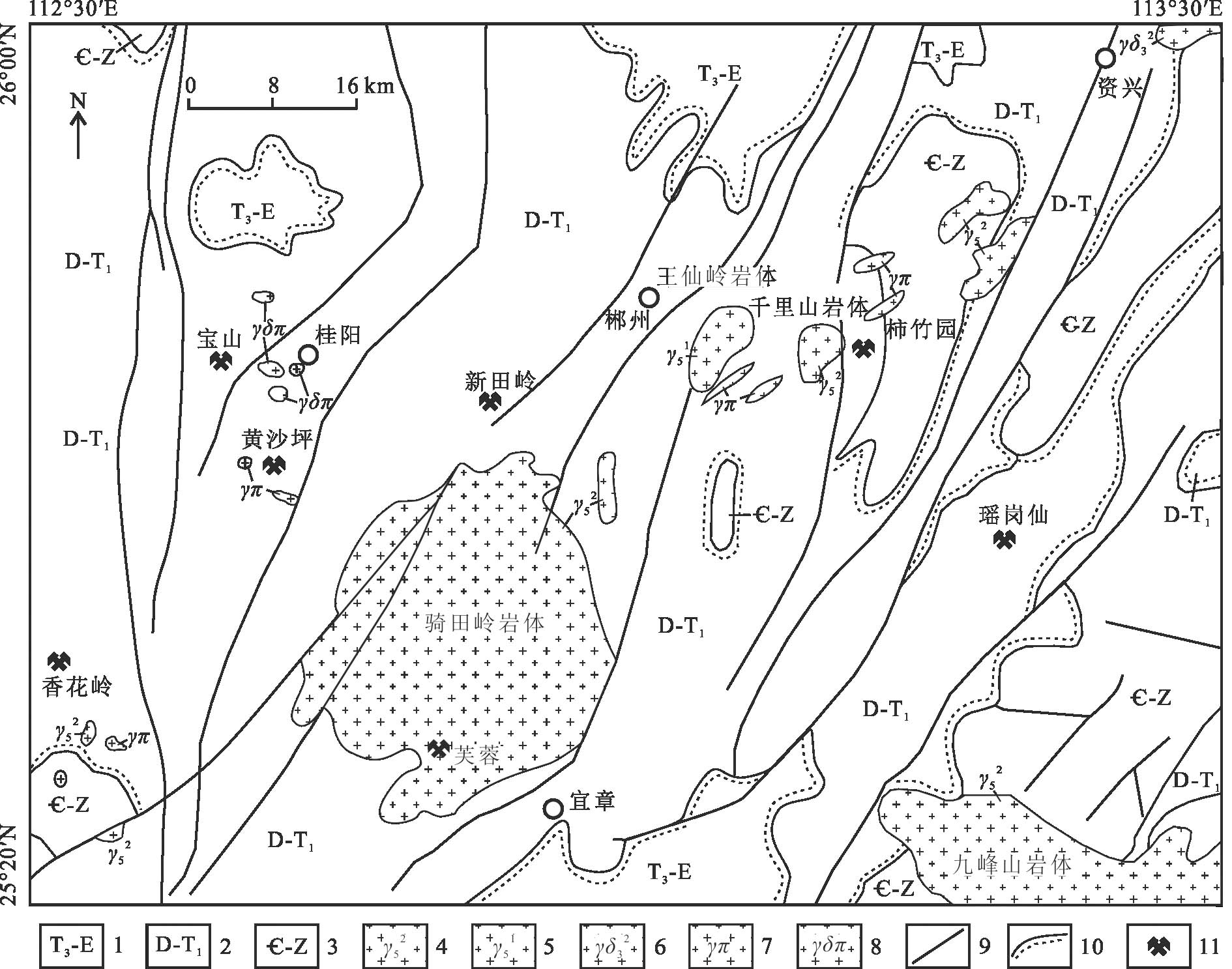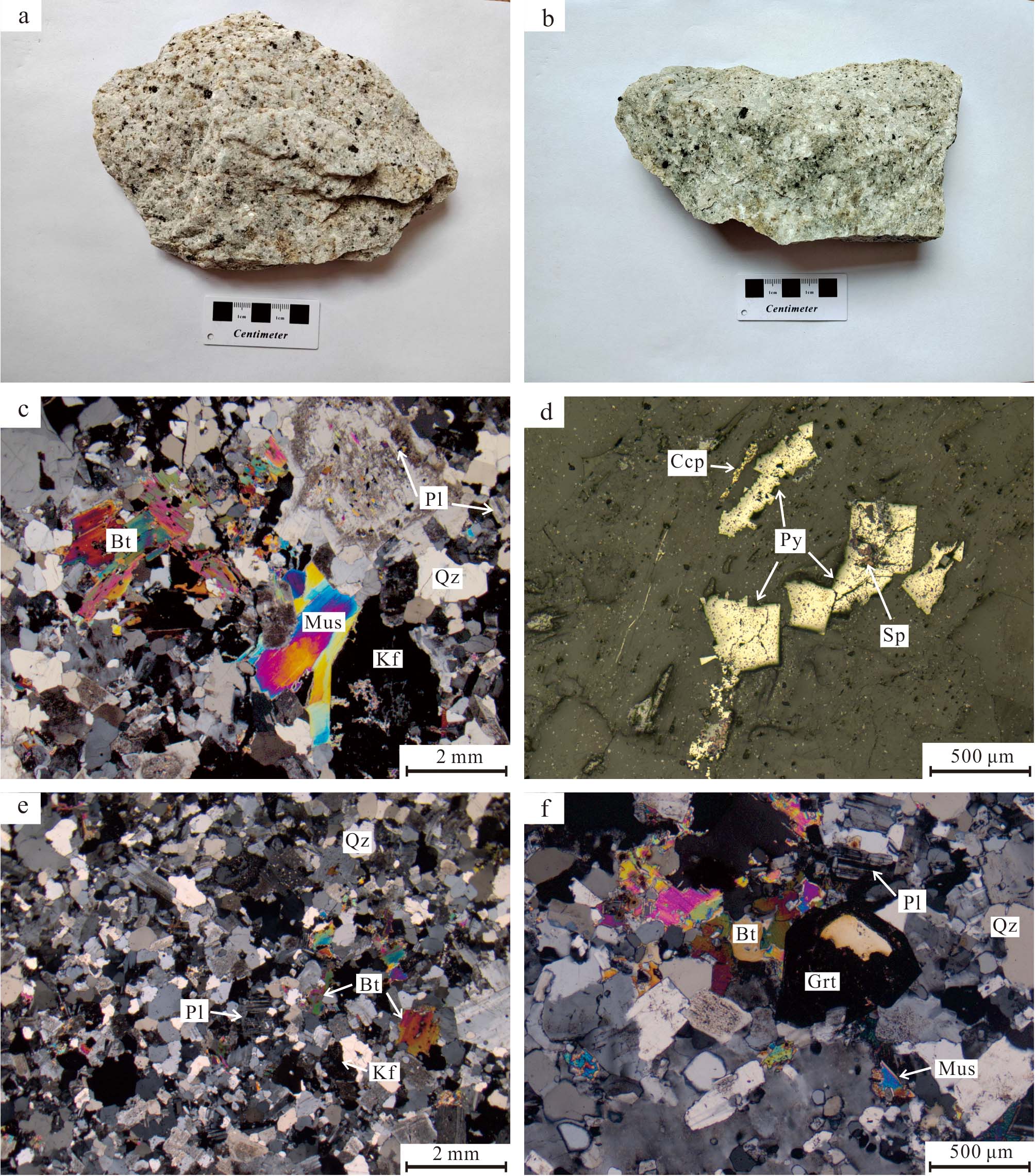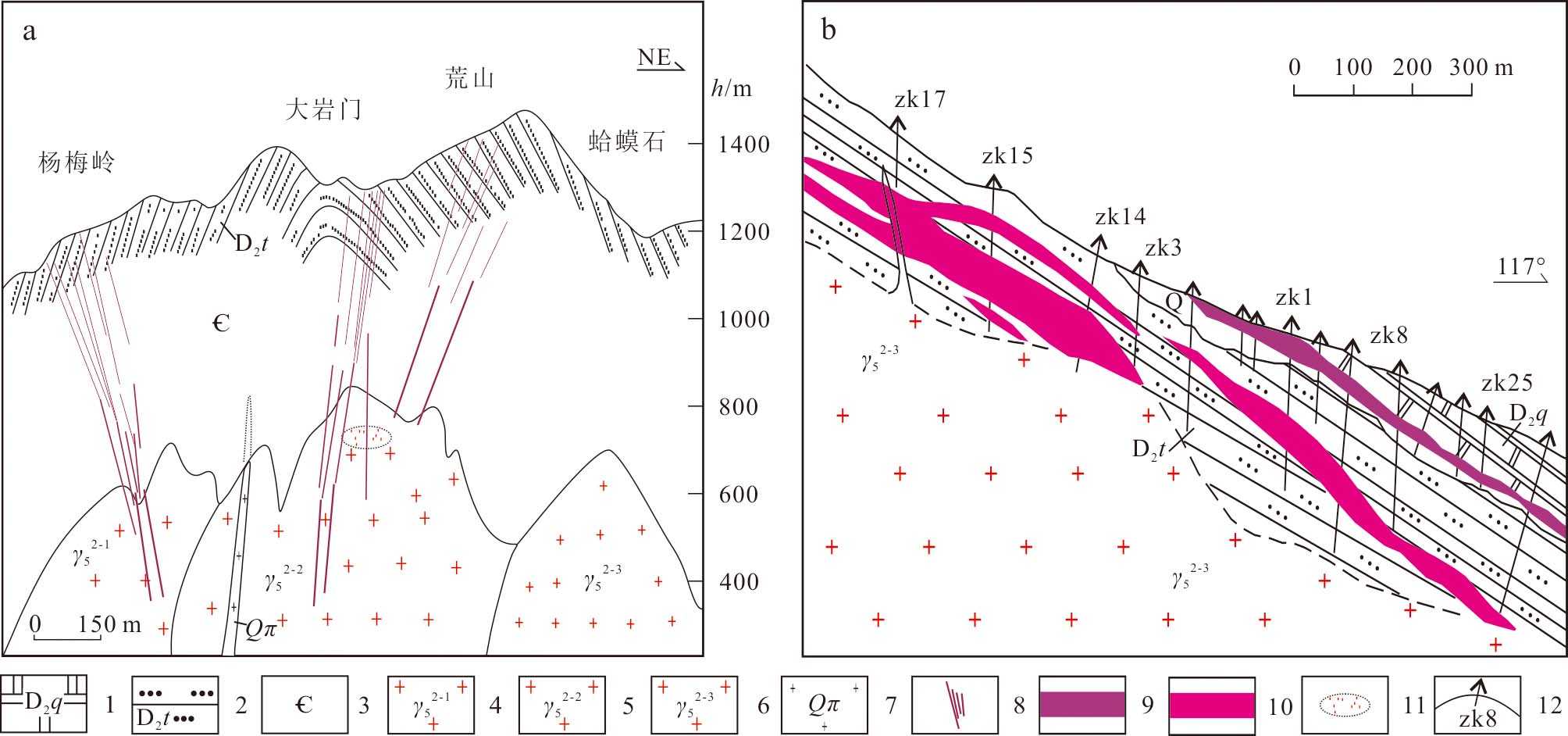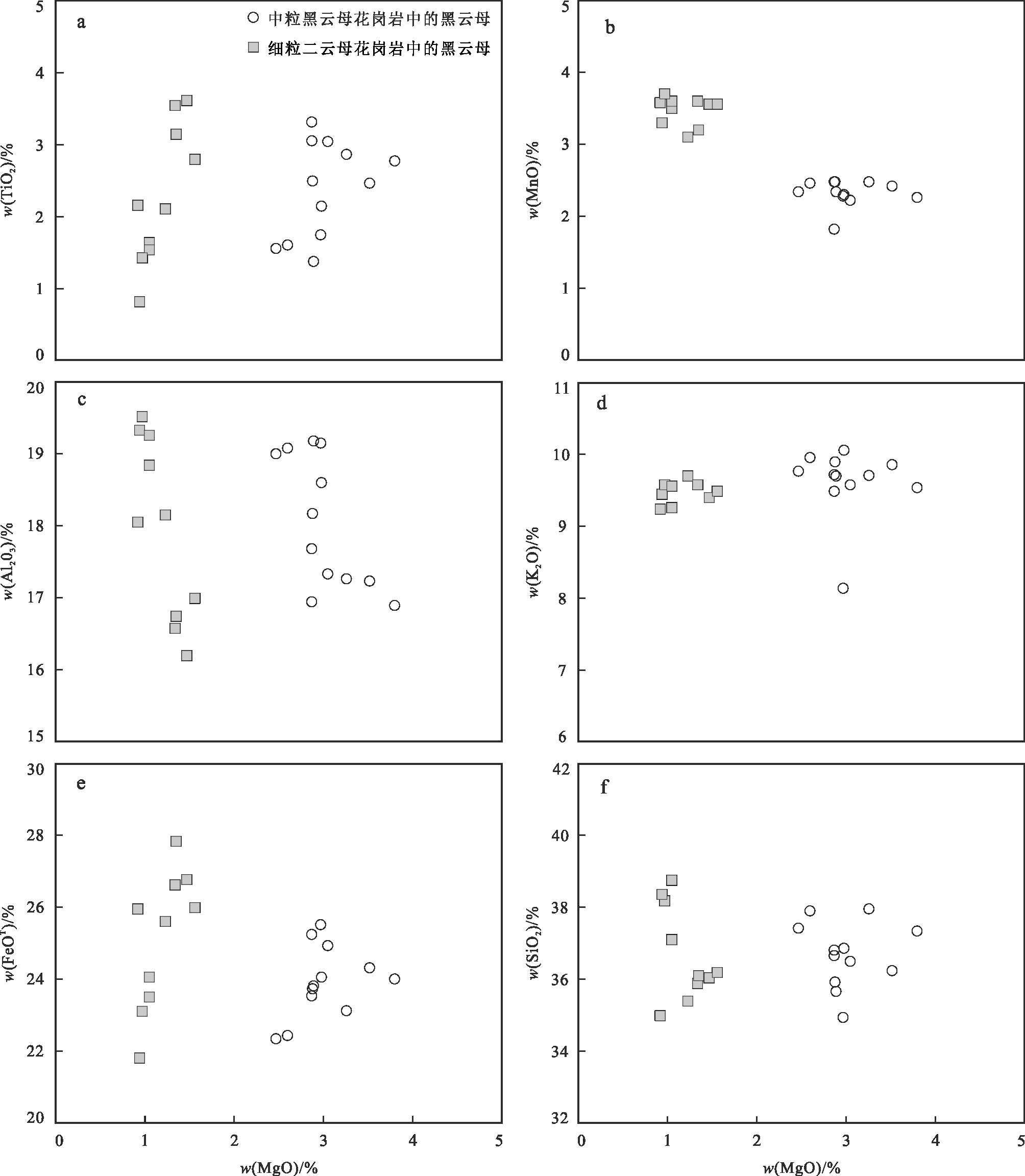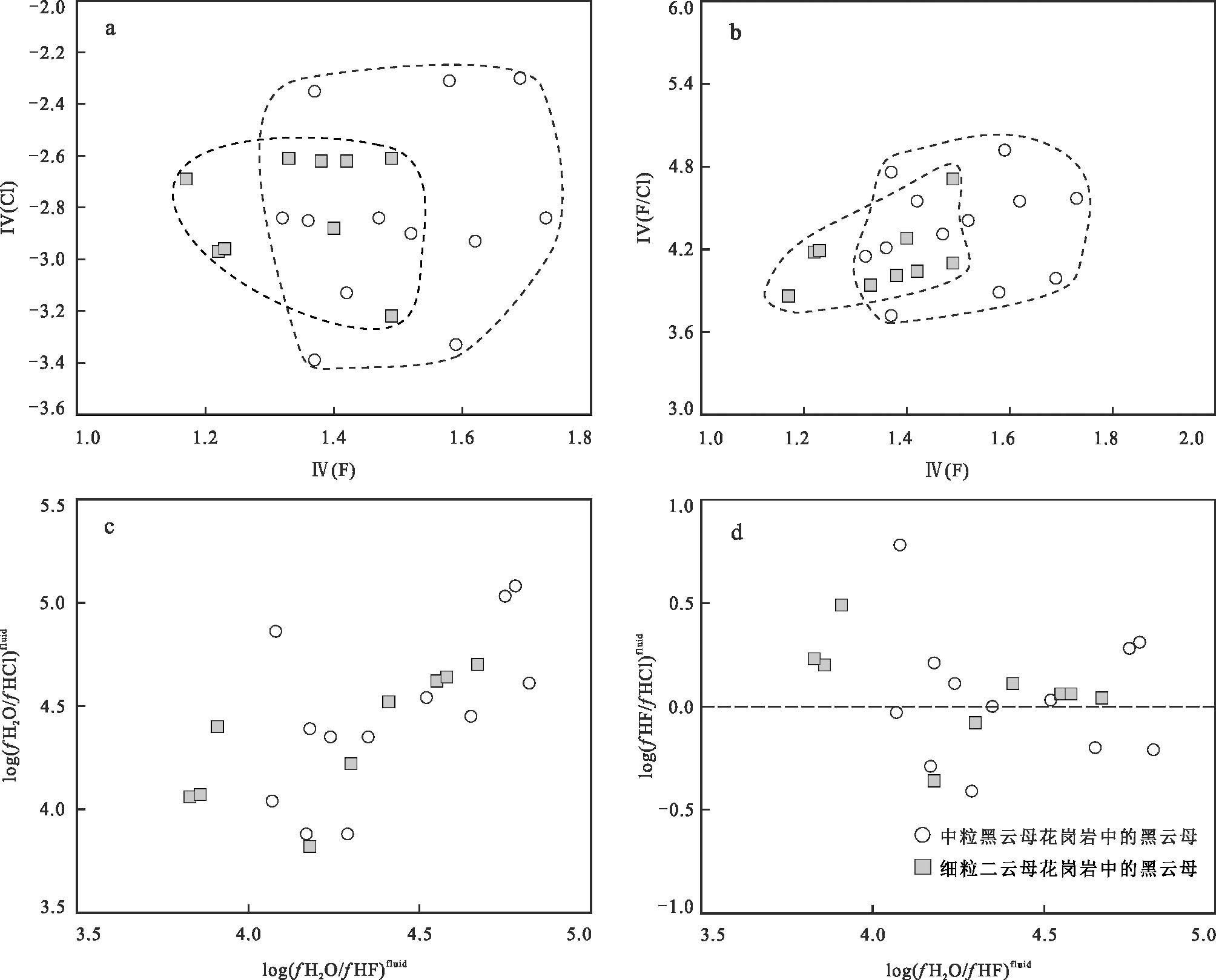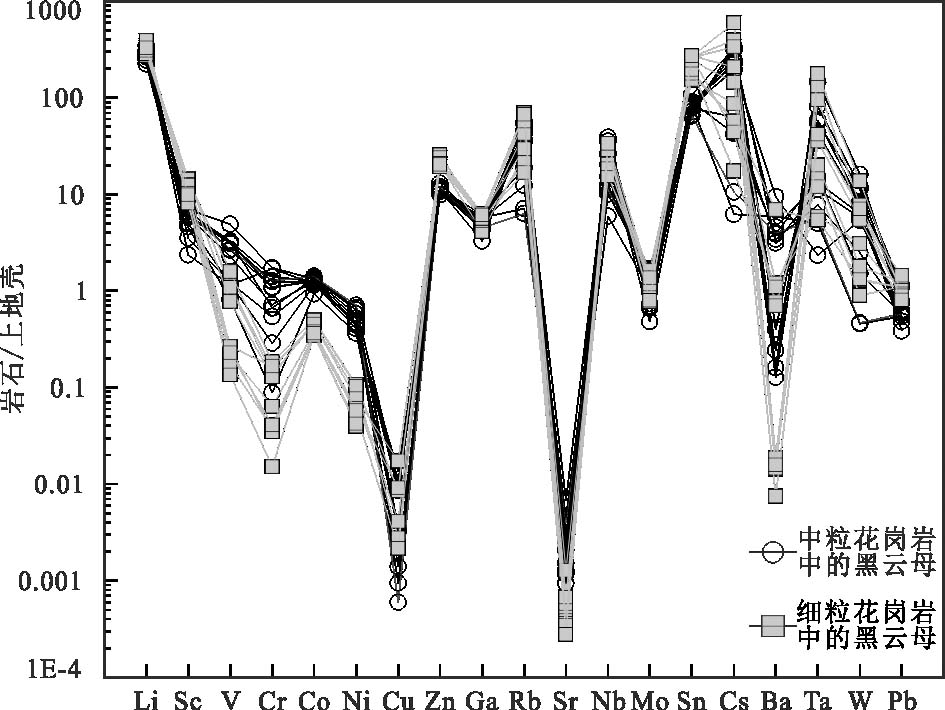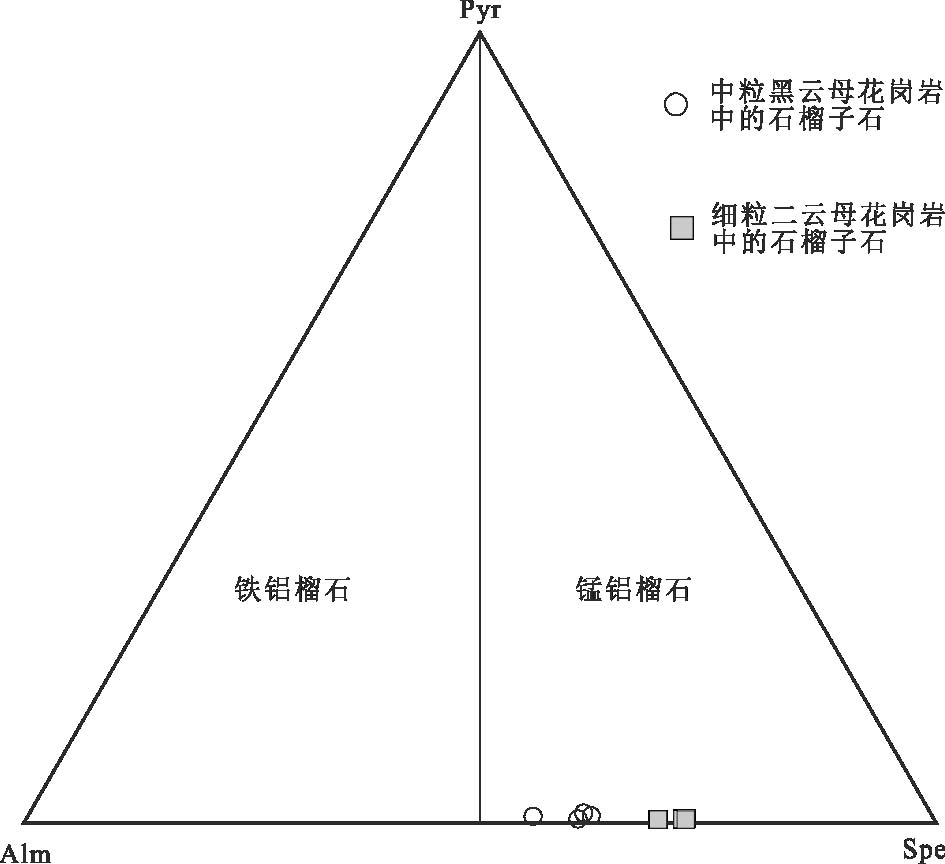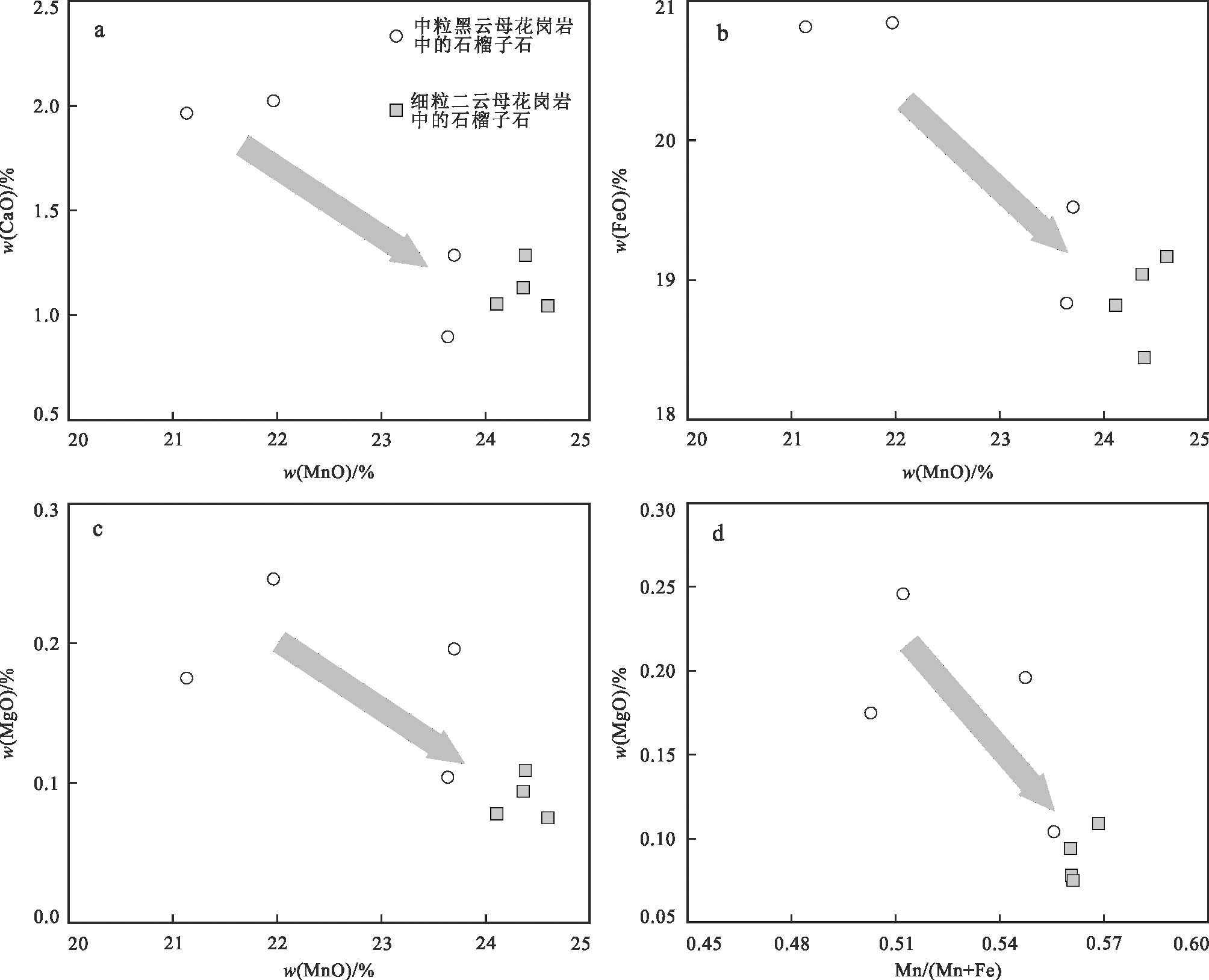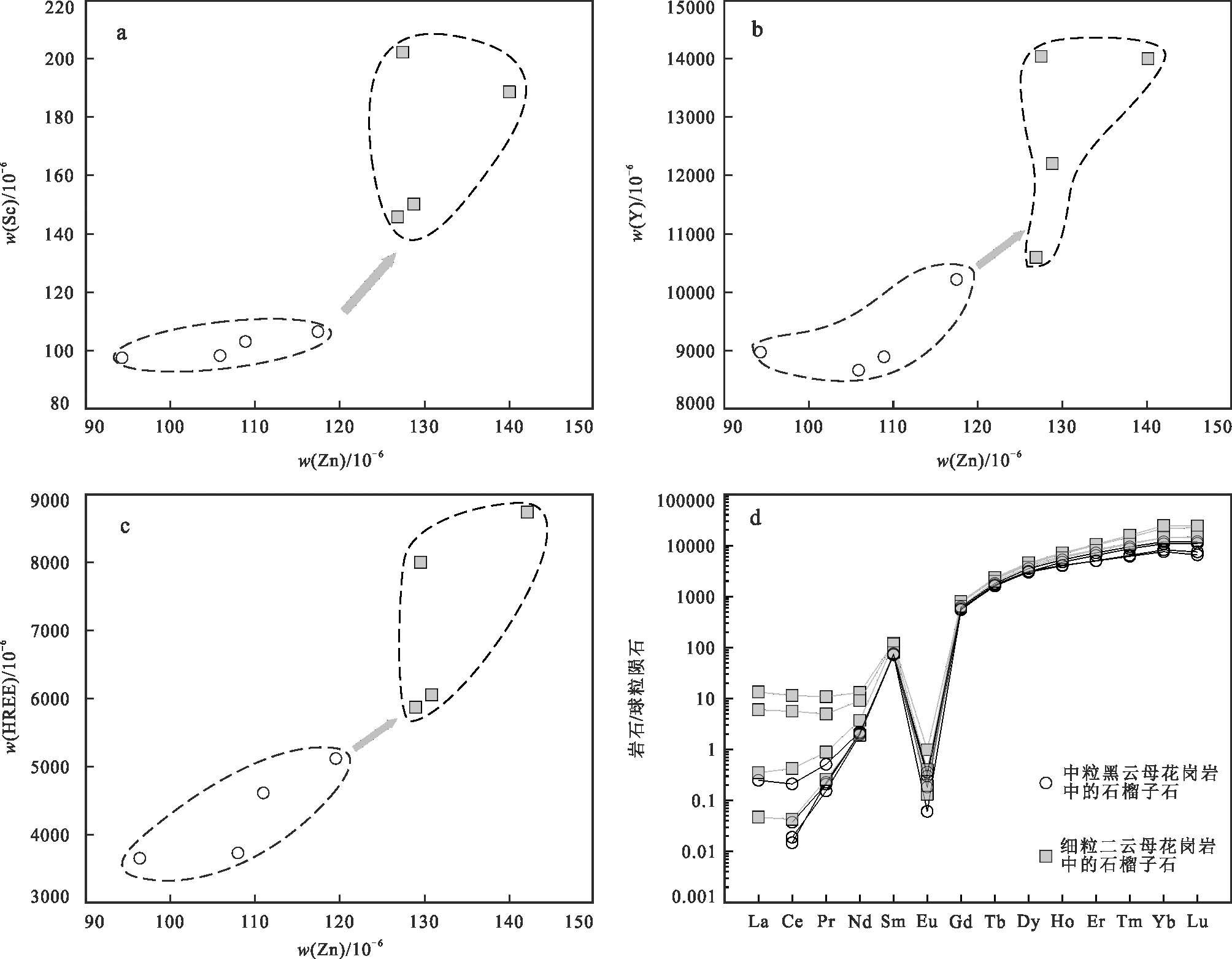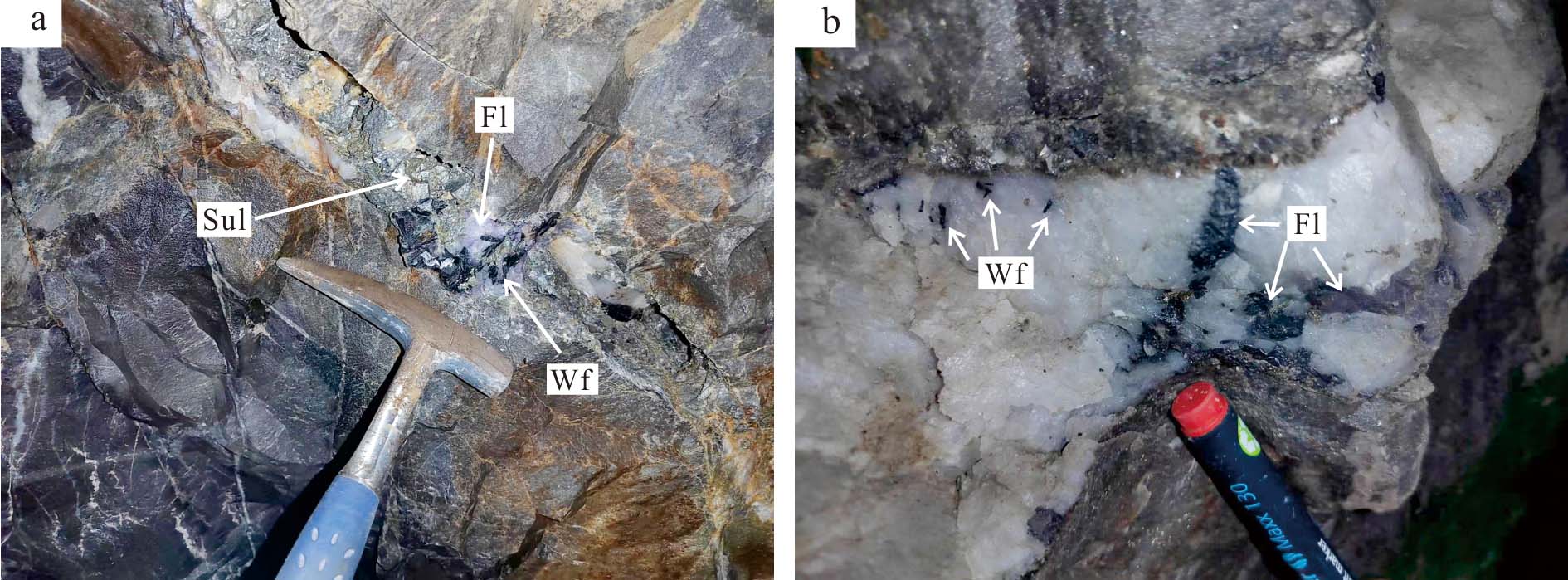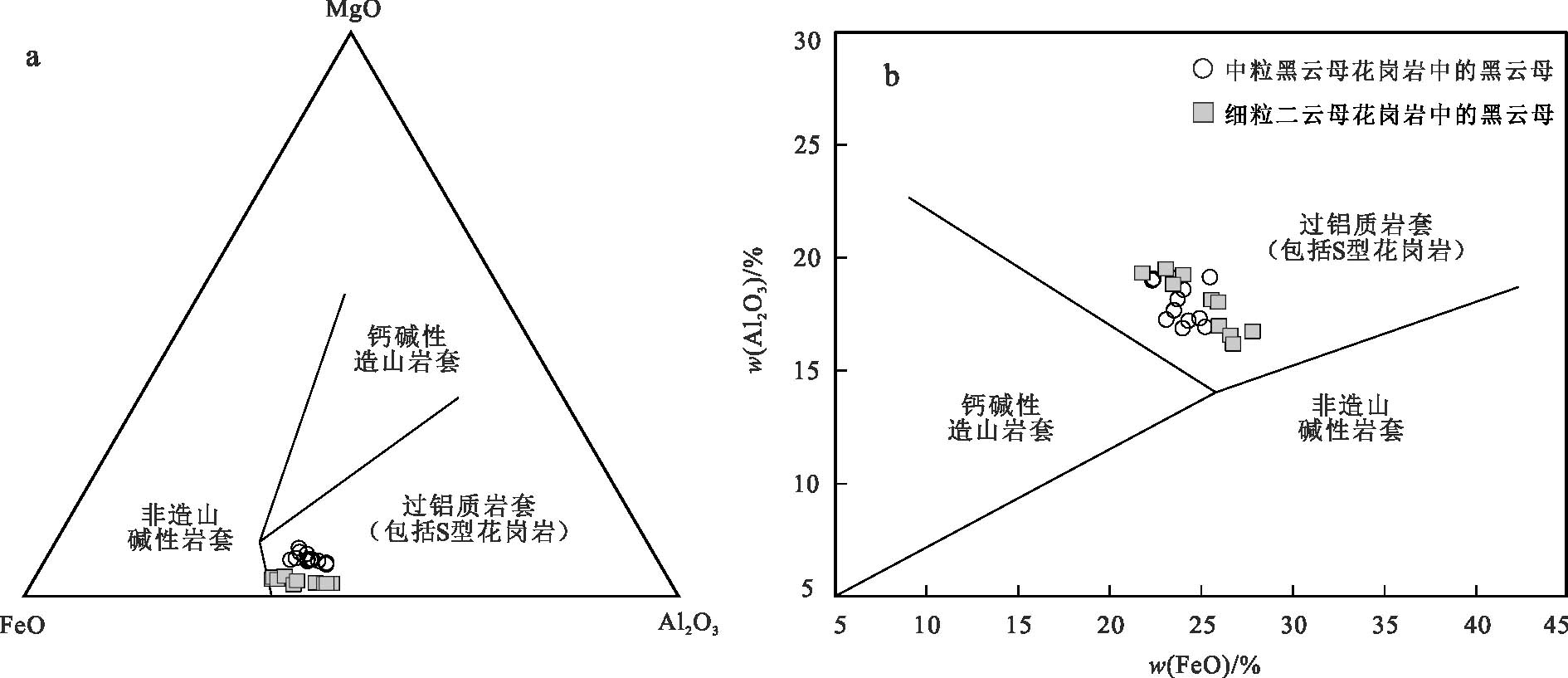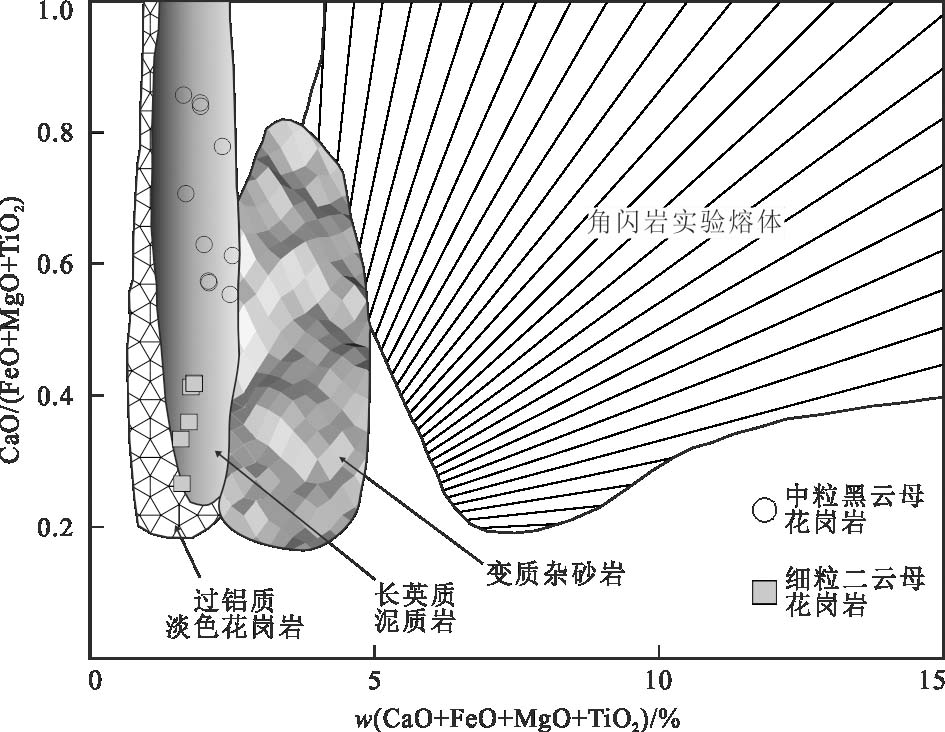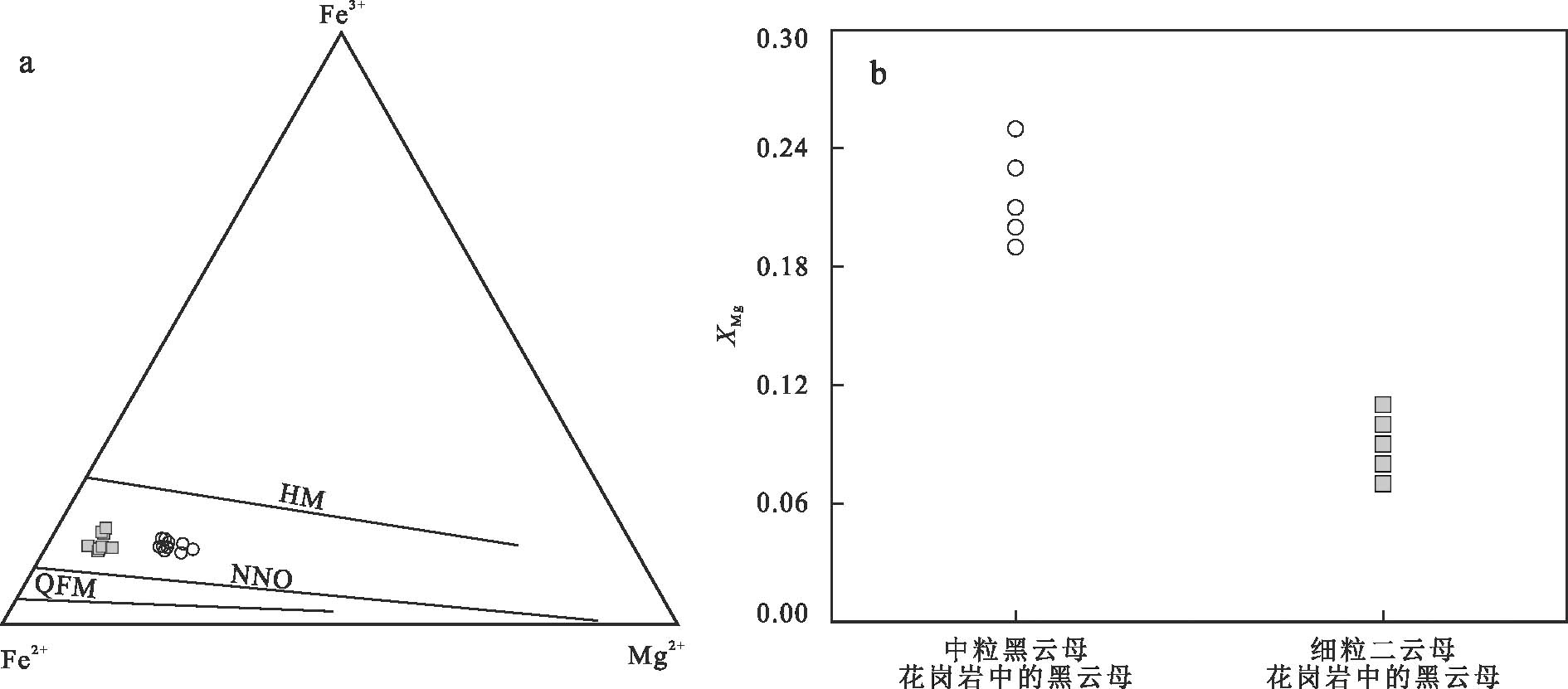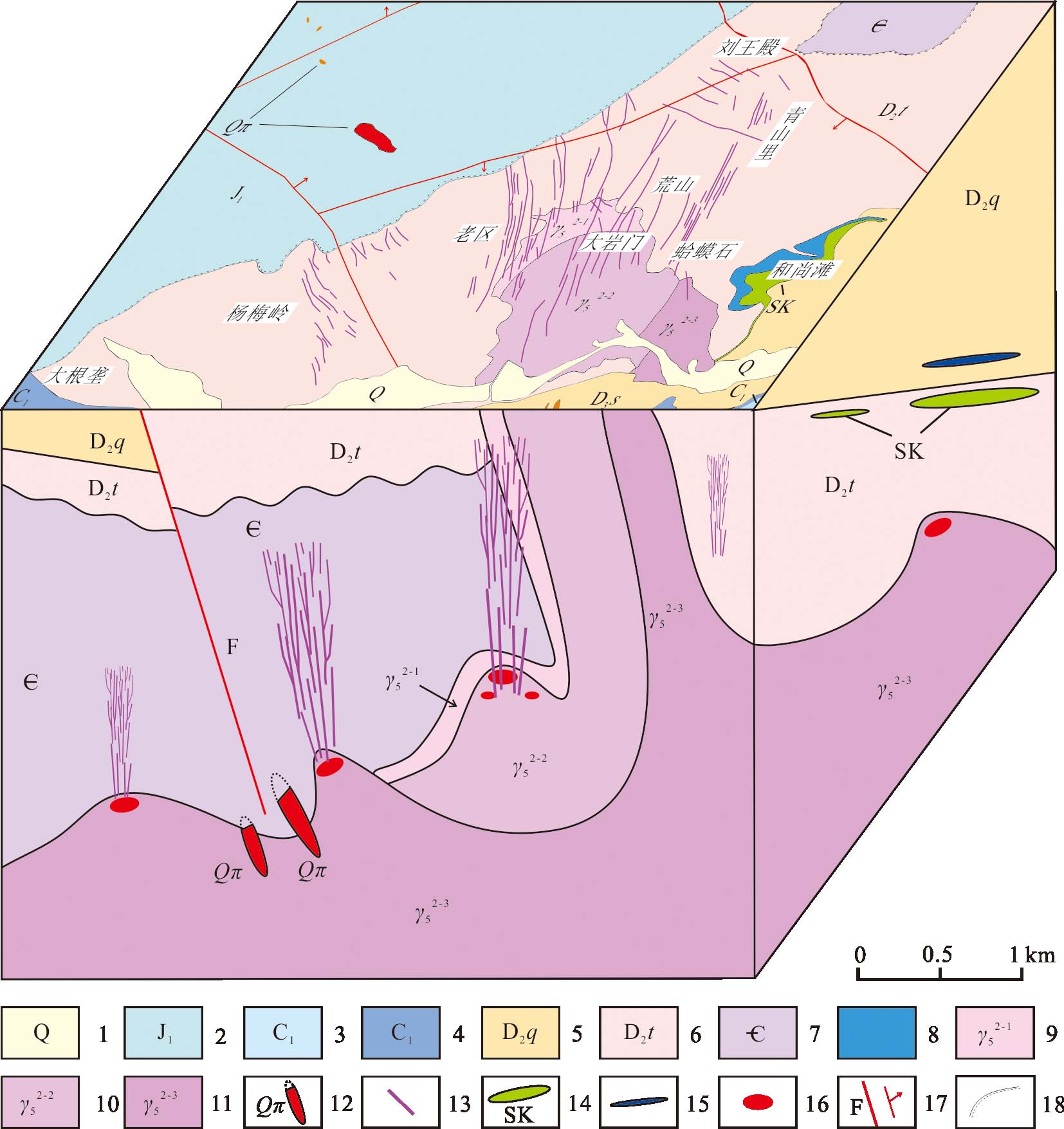-
瑶岗仙矿床作为南岭地区最大的钨多金属矿床之一,矿区石英脉型黑钨矿(23.6万吨WO3,Zhao et al.,2021)和矽卡岩型白钨矿(约31万吨WO3,Zhao et al.,2017)均达超大型规模。然而,关于矿区出露的复式花岗岩岩体与两类钨矿成因关系问题争论颇多,部分学者依据花岗岩与钨矿化空间关系,认为西段中粒黑云母二长花岗岩和东段细粒二云母二长花岗岩分别为石英脉型黑钨矿和矽卡岩型白钨矿的成矿岩体(董少花等,2014;祝新友等,2014;李顺庭等,2015)。Wang等(2018)根据矿区石英脉型黑钨矿与细粒二云母二长花岗岩中热液锆石相近的年龄与εHf(t)值,认为石英脉型钨矿矿化与细粒二云母二长花岗岩更为密切;Li等(2020)根据所测矿区细粒二云母二长花岗年龄(157 Ma)相比于中粒黑云母二长花岗岩(161 Ma)更为接近石英脉型黑钨矿化年龄(158 Ma),认为随着细粒二云母二长花岗岩侵位,同时形成石英脉型黑钨矿与矽卡岩型白钨矿。上述观点主要依据成岩成矿时空关系得出,但所获得的同位素年龄在误差范围内差别不大,无法区分哪一阶段花岗岩与钨矿化更为密切,由于石英脉型钨矿与矽卡岩型钨矿具有不同的控矿要素和勘查标识,上述争论也限制了矿区进一步勘查部署。
黑云母和石榴子石作为酸性岩浆岩常见的矿物,其特殊的晶体化学结构使其成为岩浆-热液过程的“记录者”(Speer,1984;Pownall et al.,2023;Zhao et al.,2023a)。黑云母中F、Cl含量能够表征流体中相关挥发分的富集程度(Munoz,1984;Zhu et al.,1991),其Fe3+/Fe2+比值是估算岩浆氧逸度的有效手段(David et al.,1965;Borisov et al.,1990;林文蔚等,1994)。石榴子石是Zr、Hf、Y、V和HREE的重要载体,其微量元素组成是示踪岩浆-热液体系演化的有效手段(Gaspar et al.,2008;Baghban et al.,2016;Zhao et al.,2023b)。本文利用花岗岩中的黑云母、石榴子石矿物地球化学成分探讨了两阶段岩浆体系的氧逸度、挥发分、结晶分异程度等的差别,最后分析了复式岩体与钨成矿的关系,为矿区进一步勘查提供理论基础。
1区域地质瑶岗仙钨矿床是湘南矿集区的重要组成,大地构造上位于华夏地块西北部(Wang et al.,2008)。
区内地层发育较为齐全,除缺失奥陶系和志留系外,从早到晚由震旦系至第四系皆有发育(图1)。其中寒武系碎屑岩和泥盆系中统跳马涧组石英砂岩为区域内石英脉型钨矿化的主要赋矿层位;泥盆系中统棋梓桥组白云质灰岩、上统佘田桥组泥质条带灰岩是区域内矽卡岩型钨矿化的主要赋矿地层。
区域上经历了加里东期、海西—印支期、燕山期、喜马拉雅期多构造旋回作用,从而造就了区内断裂构造格局主要以北东向、北西向、东西向为主,局部地区发育有南北向断裂。北东向断裂为该区最重要的构造带,自东向西主要包括桂东-汝城断裂、彭公庙-瑶岗仙断裂、茶陵-郴州断裂、攸县-耒阳断裂(舒良树,2006),总体走向约NE 30°。
区域岩浆活动频繁,花岗岩出露面积广泛,火山、浅火山岩出露面积较小。花岗岩时代上由早到晚可划分为加里东期、印支期、燕山期,其中燕山期花岗岩与W、Sn成矿最为密切,多呈岩墙、岩脉、岩株、岩瘤等形式产出,如千里山岩体、瑶岗仙岩体、香花岭岩体等。
区域矿产资源丰富,有色金属(钨、锡、铍、铜、铅、锌、锑等)为该区优势资源,其中又以钨锡矿最负盛名,该区汇聚了50多处以钨锡多金属矿化为主的矿床。区域钨矿床以内生成因为主,个别为外生成因。内生成因钨矿床又可细分为接触交代矽卡岩型、沿层交代矽卡岩型、石英脉型、云英岩-石英脉型、面状云英岩型等,其中当属石英脉型、云英岩-石英脉型矿体品位最高,平均品位:WO3 0.49%~2.47%、Mo 0.05%~0.20%、Bi 0.05%~0.50%(张怡军等,2014)。钨矿床(矿点、矿化点)主要分布于东南侧加里东隆起带,但整体矿化规模较小;中-大型规模矿床多分布于中部隆起-拗陷过渡带,如柿竹园、瑶岗仙等超大型矿床。
图1 湘南瑶岗仙钨矿构造位置及湘南区域地质简图(据黄革非等,2003改编) 1—上三叠统—古近系砂岩和粉砂岩;2—泥盆系—下三叠统灰岩和页岩;3—震旦系—寒武系板岩和变质砂岩;4—燕山早期花岗岩;5—印支期花岗岩;6—加里东期花岗闪长岩;7—花岗斑岩;8—花岗闪长斑岩;9—断裂;10—不整合界线;11—金属矿床
Fig.1 Tectonic position of Yaogangxian tungsten deposit and regional geological map of southern Hunan(modified after Huang et al., 2003) 1—Upper Triassic to Paleogene sandstone and siltstone; 2—Devonian to Lower Triassic limestone and shale; 3—Sinian to Cambrian slate and meta-sandstone; 4—Early Yanshanian granite; 5—Indosinian granite; 6—Caledonian granodiorite; 7—Granite porphyry; 8—Granodiorite porphyry; 9—Fault; 10—Unconformity; 11—Metal deposit
2矿床地质2.1岩体地质根据瑶岗仙各类花岗岩侵位关系、岩体地质和岩相学特征,将矿区岩浆岩划分为4个阶段:①中粗粒似斑状黑云母二长花岗岩;②中粒黑云母二长花岗岩;③细粒二云母二长花岗岩;④石英斑岩(图2)。中粗粒似斑状黑云母二长花岗岩为矿区第一阶段花岗岩,产出于岩体NW端及岩体顶部。中粒黑云母二长花岗岩为矿区第二阶段花岗岩,岩体北侧、南侧分别侵入跳马涧组砂岩和佘田桥组灰岩中。细粒二云母二长花岗岩为矿区第三阶段花岗岩,分布于复式岩体南东侧,呈楔形北东向展布于中粒黑云母二长花岗岩与跳马涧组砂岩间。前人野外考察见该阶段岩体侵入中粒黑云母二长花岗岩中,表明其形成时代稍晚于后者,在后者未完全固化之前侵位而成(李顺庭等,2011)。石英斑岩主要分布于矿区南部,整体呈NW向延伸,地表未见出露,仅在杨梅岭地区坑道内揭露,从其穿插早期形成的黑钨矿石英脉现象推测其为成矿后阶段产物,与成矿关系不大。各阶段花岗岩整体表现为高钾钙碱性、弱过铝质、相对富集重稀土元素、高分异的特征(陈依壤,1988;孙健等,2009;董少花等,2014;Li et al.,2020),第一阶段花岗岩体形成于170 Ma(董少花等,2014),与矿区成矿时代相差甚远,后三阶段花岗岩体形成时代较为接近,集中于157~161 Ma(李顺庭等,2011;Li et al.,2020),中粒黑云母二长花岗岩、细粒二云母二长花岗岩与矿区钨矿化最为密切。
图2瑶岗仙钨矿床矿区地质图(据湖南瑶岗仙矿业有限责任公司未公布数据,2013修改)1—第四系;2—侏罗系下统砂岩;3—石炭系下统灰岩;4—石炭系下统页岩;5—泥盆系中统棋梓桥组和上统佘田桥组灰岩;6—泥盆系中统跳马涧组砂岩;7—寒武系变质砂岩;8—矽卡岩化板岩;9—燕山期第一阶段花岗岩;10—燕山期第二阶段花岗岩;11—燕山期第三阶段花岗岩;12—石英斑岩;13—石英脉型黑钨矿体;14—矽卡岩型白钨矿体;15—断层;16—不整合界线
Fig.2 Geological map of the Yaogangxian tungsten deposit (modified after unpublished data provided by Hunan YaogangxianMining Co. Ltd., 2013)1—Quaternary; 2—Lower Jurassic sandstone; 3—Lower Carboniferous limestone; 4—Lower Carboniferous shale; 5—Middle Devonian Qiziqiao Formation and Upper Devonian Shetianqiao Formation limestone; 6—Middle Devonian Tiaomajian Formation sandstone; 7—Cambrian meta-sandstone; 8—Slate with skarnization; 9—First stage Yanshanian granite; 10—Second stage Yanshanian granite; 11—Third stage Yanshanian granite;12—Quartz porphyry; 13—Quartz vein-type wolframite orebodies; 14—Skarn-type scheelite orebodies; 15—Fault; 16—Unconformity
中粒黑云母二长花岗岩呈白色,中粒-中细粒,斑状结构,斑晶为斜长石、钾长石,斑晶粒径为2~4 mm,基质为中粒花岗结构(图3a)。主要矿物石英(30%~35%)、钾长石(他形,20%~25%)、斜长石(板状、柱状,25%~30%)、云母(5%~10%)、石榴子石及少量硫化物(黄铁矿、黄铜矿、闪锌矿)(图3c、d)。蚀变类型主要为钾长石的泥化和钠长石化、斜长石的绢云母化。云母类型以黑云母为主,自形程度较好,单偏光下呈褐色,蚀变较弱;白云母含量甚微,原生白云母更为少见,多数受热液蚀变而成。细粒二云母二长花岗岩呈浅灰白色,细粒花岗结构(图3b),主要矿物为钾长石、斜长石、石英、云母,矿物粒径集中于1~2 mm。钾长石,半自形,部分区域发育有卡纳复式双晶,含量25%~30%。斜长石,半自形板状,聚片双晶明显,含量约25%。石英,含量约35%,呈他形粒状分布,表面较为干净。云母,含量约5%。黑云母边缘多呈锯齿状,石英、长石等环绕其分布,表明其形成早于石英、长石,边缘形态受后期热液溶蚀所致;白云母分为原生与次生两种类型,次生白云母由黑云母蚀变而成,多分布于黑云母附近或呈黑云母假晶(图3e)。副矿物主要为石榴子石(含量约1%),呈环状产出(图3f),单偏光下可见正极高突起。
图3瑶岗仙矿区代表性岩浆岩岩相学照片a.中粒黑云母二长花岗岩手标本照片;b.细粒二云母二长花岗岩手标本照片;c.中粒黑云母二长花岗岩中他形黑云母和白云母,正交偏光;d.中粒黑云母二长花岗岩中黄铁矿-黄铜矿-闪锌矿矿物组合,反射光;e.细粒二云母二长花岗岩中他形黑云母填隙生长于石英粒间,正交偏光;f.细粒二云母二长花岗岩中的环状石榴子石,正交偏光Qz—石英;Kf—钾长石;Pl—斜长石;Bt—黑云母;Mus—白云母;Grt—石榴子石;Ccp—黄铜矿;Py—黄铁矿;Sp—闪锌矿
Fig.3 Petrographic characteristics of typical granitoids from the Yaogangxian deposita. Hand specimen photograph of medium-grained biotite monzogranite; b. Hand specimen photograph of fine-grained two-mica monzogranite; c. Anhedral biotite and muscovite in medium-grained biotite monzogranite, cross-polarized ; d. Assemblage of pyrite-chalcopyrite-sphalerite in medium-grained biotite monzogranite, reflected light; e. Anhedral biotite precipitates within the interstices of quartz grains in fine-grained two-mica monzogranite, cross-polarized; f. Ring garnet in fine-grained two-mica monzogranite, cross-polarizedQz—Quartz; Kf—K-feldspar; Pl—Plagioclase; Bt—Biotite; Mus—Muscovite; Grt—Garnet; Ccp—Chalcopyrite; Py—Pyrite; Sp—Sphalerite
2.2矿体地质石英脉型黑钨矿围绕第二阶段岩体NW端分布于内外接触带中,平面上自东向西依次发育NNW向、NW向、NWW向3组脉体,主要分布于蛤蟆石、荒山、大岩门、杨梅岭等地区。NNW向矿脉主要分布于蛤蟆石-大岩门一带,绝大部分产于跳马涧组砂岩中。蛤蟆石附近脉体走向NW 340°~NNE 5°,倾角陡立,一般>70°;大岩门附近脉体走向345°~360°,倾向SW、倾角65°~85°,脉宽集中于0.2~0.3 m,厚0.15~1.20 m,地表出露长度最大达800 m。NW向脉体主要产于荒山附近,脉体走向315°~345°,倾向以SW为主,偶见NE,倾角70°~85°,矿脉延深、延长巨大,地表长度最长达1200 m,延深最深为800 m,厚0.1~1.8 m。NWW向脉体分布于大岩门-杨梅岭一带,以杨梅岭为主。大岩门附近脉体走向285°~315°,倾向SW或NE,倾角60°~80°,平均厚度0.48~0.90 m,其中包括矿区“王牌”矿脉501、501-XM细脉带等,厚度最大者达22.03 m,脉体沿走向最长达920 m;杨梅岭附近脉体走向290°~317°,倾向NE,倾角60°~84°,脉体沿走向最长达600 m,厚度一般为0.24~1.45 m。三组矿脉地表呈大致等距、自SE向NW散开的帚状,从地表向下纵贯泥盆系、寒武系盖层,脉体总体呈直立产出,向下延伸较大,由地表的密集细、线脉带向下逐渐归并、变大,分支复合现象明显(图4a)。石英脉型矿化矿物组合主要为黑钨矿+锡石+辉钼矿+黄铜矿+毒砂+黄铁矿,一般油脂光泽强烈的石英脉里钨矿化都较好,结晶粒度粗大,常与硫化物共生,黑钨矿晶体呈板状平行于石英脉边缘垂直生长。
图4瑶岗仙矿床石英脉型矿化剖面示意图(a)与矽卡岩型白钨矿床1号勘探线图(b,据湖南瑶岗仙矿业有限责任公司未公布数据修改,1954)1—中泥盆统棋梓桥组碳酸盐岩;2—中泥盆统跳马涧组砂岩;3—寒武系变质砂岩;4—燕山期第一阶段花岗岩;5—燕山期第二阶段花岗岩;6—燕山期第三阶段花岗岩;7—石英斑岩;8—石英脉型黑钨矿体;9—矽卡岩型白钨矿体;10—细脉浸染型白钨矿体;11—云英岩型矿体;12—钻孔及编号
Fig.4 Sketch cross section of quartz vein-type mineralization (a) and cross section at No. 1 exploration line of skarn-type scheelite ores through the Yaogangxian deposit (b, modified after unpublished data provided by Hunan Yaogangxian Mining Co. Ltd., 1954)1—Middle Devonian Qiziqiao Formation carbonate; 2—Middle Devonian Tiaomajian Formation sanstone; 3—Cambrian meta-sandstone; 4—First stage Yanshanian granite; 5—Second stage Yanshanian granite; 6—Third stage Yanshanian granite; 7—Quartz porphyry; 8—Quartz vein-typewolframite orebodies; 9—Skarn-type scheelite orebodies; 10—Veinlet disseminated-type scheelite orebodies; 11—Greisen-type orebodies;12—Drill hole and its numbers
矽卡岩型白钨矿分布于矿区东段“和尚滩”地区,形成于棋梓桥组灰岩与跳马涧组砂岩接触部位,走向NE 30°~35°,倾向SE,倾角30°~35°,距离花岗岩体80~240 m,其间以跳马涧组砂岩相隔。此外,跳马涧组砂岩层还发育有细脉砂岩型贫白钨矿矿体,矿体顺层产出,呈似层状和透镜状分布(图4b)。矿区发育2期矽卡岩型白钨矿,早期白钨矿晶型发育较好,呈自形-半自形粒状结构,整体呈条带状;晚期白钨矿自形程度较差,以半自形粒状为主,整体分布呈浸染状(于志峰等,2022),常见其与方解石共生,钨灯照射下白钨矿显示出特征性蓝色,方解石为红色。
3样品采集及测试方法中粒黑云母花岗岩采集于蛤蟆石附近的23中段(N 25°39′10″,E 113°18′57″,H 543 m),采样位置远离脉体,受后期热液活动影响较小,样品整体较为新鲜。细粒二云母二长花岗岩采集于和尚滩附近的26中段(N 25°38′50″,E 113°19′45″,H 421 m),采样位置远离脉体,样品较为新鲜。
通过显微镜下鉴定,选择干涉色均一且在背散射上显示化学成分均一的黑云母,自形程度良好、蚀变较弱的石榴子石进行电子探针分析。电子探针测试在中国地质科学院矿产资源研究所电子探针实验室进行,黑云母和石榴子石成分分析采用日本电子JOEL公司生产的JXA-8230型电子探针分析仪,加速电压为15 kV,束流为20 nA,束斑大小为5 μm,数据校正采用ZAF校正程序。黑云母测试项包括SiO2、Al2O3、TiO2、FeO、MnO、MgO、CaO、Na2O、K2O、F、Cl等,石榴子石测试项包括SiO2、TiO2、Al2O3、FeO、MnO、MgO、CaO、Na2O、K2O、P2O5、F、Cl、Nb2O5等,标样采用天然矿物或合成金属氧化物国家标准,分析精度约为0.01%。
表1瑶岗仙矿区黑云母主量元素及相关计算结果
Table 1 Major elements and calculation results of biotite from the Yaogangxian deposit
组分
中粒黑云母二长花岗岩
细粒二云母二长花岗岩
YGX-
23-1-
1
YGX-
23-1-
2
YGX-
23-1-
3
YGX-
23-1-
4
YGX-
23-1-
5
YGX-
23-1-
6
YGX-
23-1-
7
YGX-
23-1-
8
YGX-
23-1-
9
YGX-
23-1-
10
YGX-
23-1-
11
YGX-
23-1-
12
YGX-
26-1-
1
YGX-
26-1-
2
YGX-
26-1-
3
YGX-
26-1-
4
YGX-
26-1-
5
YGX-
26-1-
6
YGX-
26-1-
7
YGX-
26-1-
8
YGX-
26-1-
9
YGX-
26-1-
10
w(B)/%
SiO2
36.66
36.50
36.24
37.34
37.96
36.81
35.66
37.90
34.94
36.86
37.42
35.92
38.76
34.98
35.88
36.10
36.04
36.19
35.39
38.18
37.10
38.36
TiO2
3.31
3.04
2.46
2.77
2.86
3.05
1.37
1.60
1.74
2.14
1.55
2.49
1.63
2.15
3.54
3.14
3.61
2.79
2.10
1.42
1.53
0.81
Al2O3
16.94
17.33
17.23
16.89
17.26
17.68
19.18
19.08
19.15
18.60
19.00
18.17
19.26
18.05
16.57
16.74
16.19
16.99
18.15
19.52
18.84
19.33
FeO
25.24
24.93
24.31
24.00
23.12
23.53
23.81
22.43
25.51
24.05
22.34
23.73
24.05
25.95
26.62
27.83
26.77
25.99
25.60
23.10
23.50
21.80
MnO
0.91
1.11
1.21
1.13
1.24
1.24
1.17
1.23
1.14
1.15
1.17
1.24
1.75
1.79
1.80
1.60
1.78
1.78
1.55
1.85
1.80
1.65
MgO
2.87
3.05
3.52
3.80
3.26
2.87
2.89
2.60
2.97
2.98
2.47
2.88
1.05
0.92
1.34
1.35
1.47
1.56
1.23
0.97
1.05
0.94
CaO
0
0
0
0
0
0
0
0
0
0
0
0
0
0
0
0
0
0
0
0
0
0
Na2O
0.07
0.03
0.05
0.13
0.15
0.15
0.11
0.02
0.03
0.04
0.06
0.09
0.08
0.11
0.05
0.09
0.10
0.06
0.14
0
0.14
0.07
K2O
9.72
9.58
9.86
9.54
9.71
9.49
9.70
9.96
8.14
10.06
9.77
9.90
9.56
9.24
9.58
9.58
9.40
9.49
9.70
9.58
9.26
9.45
F
0.89
0.65
1.06
0.70
0.81
1.01
0.76
0.63
0.48
0.47
1.04
0.98
0.67
0.62
1.02
0.58
1.05
1.17
0.55
0.77
0.70
0.82
Cl
0.06
0.11
0.09
0.03
0.04
0.01
0.02
0.01
0.01
0.03
0.03
0.02
0.02
0.08
0.07
0.13
0.06
0.03
0.04
0.02
0.02
0.03
总和
96.66
96.33
96.01
96.32
96.41
95.84
94.68
95.45
94.10
96.38
94.84
95.42
96.83
93.87
96.47
97.13
96.46
96.04
94.44
95.41
93.93
93.26
以22个氧原子为基准的阳离子数
Si
5.67
5.64
5.65
5.74
5.80
5.69
5.59
5.81
5.50
5.66
5.80
5.62
5.88
5.60
5.64
5.63
5.66
5.69
5.62
5.87
5.82
5.99
Al
3.09
3.16
3.17
3.06
3.11
3.22
3.54
3.44
3.55
3.36
3.47
3.35
3.44
3.41
3.07
3.08
3.00
3.15
3.40
3.54
3.48
3.56
AlⅣ
2.33
2.36
2.35
2.26
2.20
2.31
2.41
2.19
2.51
2.34
2.20
2.39
2.12
2.40
2.36
2.37
2.34
2.31
2.38
2.13
2.18
2.01
AlⅥ
0.75
0.80
0.82
0.79
0.91
0.91
1.14
1.25
1.04
1.02
1.27
0.96
1.32
1.01
0.71
0.71
0.66
0.84
1.02
1.40
1.30
1.55
Ti
0.39
0.35
0.29
0.32
0.33
0.35
0.16
0.18
0.21
0.25
0.18
0.29
0.19
0.26
0.42
0.37
0.43
0.33
0.25
0.16
0.18
0.10
Fe3+
0.51
0.51
0.48
0.50
0.50
0.51
0.47
0.50
0.53
0.49
0.50
0.48
0.54
0.53
0.54
0.53
0.54
0.53
0.51
0.53
0.53
0.53
Fe2+
2.75
2.71
2.69
2.59
2.45
2.53
2.65
2.38
2.82
2.60
2.39
2.62
2.51
2.95
2.96
3.10
2.98
2.89
2.89
2.44
2.55
2.32
Fe3+
/Fe2+
0.19
0.19
0.18
0.19
0.20
0.20
0.18
0.21
0.19
0.19
0.21
0.18
0.22
0.18
0.18
0.17
0.18
0.18
0.18
0.22
0.21
0.23
组分
中粒黑云母二长花岗岩
细粒二云母二长花岗岩
YGX-
23-1-
1
YGX-
23-1-
2
YGX-
23-1-
3
YGX-
23-1-
4
YGX-
23-1-
5
YGX-
23-1-
6
YGX-
23-1-
7
YGX-
23-1-
8
YGX-
23-1-
9
YGX-
23-1-
10
YGX-
23-1-
11
YGX-
23-1-
12
YGX-
26-1-
1
YGX-
26-1-
2
YGX-
26-1-
3
YGX-
26-1-
4
YGX-
26-1-
5
YGX-
26-1-
6
YGX-
26-1-
7
YGX-
26-1-
8
YGX-
26-1-
9
YGX-
26-1-
10
以22个氧原子为基准的阳离子数
Mn
0.12
0.15
0.16
0.15
0.16
0.16
0.16
0.16
0.15
0.15
0.15
0.16
0.23
0.24
0.24
0.21
0.24
0.24
0.21
0.24
0.24
0.22
Mg
0.66
0.70
0.82
0.87
0.74
0.66
0.68
0.59
0.70
0.68
0.57
0.67
0.24
0.22
0.31
0.31
0.34
0.37
0.29
0.22
0.25
0.22
Na
0.02
0.01
0.02
0.04
0.04
0.05
0.03
0.01
0.01
0.01
0.02
0.03
0.02
0.03
0.02
0.03
0.03
0.02
0.04
0
0.04
0.02
K
1.92
1.89
1.96
1.87
1.89
1.87
1.94
1.95
1.63
1.97
1.93
1.95
1.85
1.89
1.92
1.91
1.88
1.90
1.97
1.88
1.85
1.88
OH*
3.54
3.65
3.44
3.65
3.59
3.50
3.61
3.69
3.76
3.76
3.47
3.50
3.66
3.66
3.47
3.67
3.45
3.40
3.71
3.61
3.64
3.58
F
0.44
0.32
0.53
0.34
0.40
0.50
0.38
0.31
0.24
0.23
0.52
0.49
0.33
0.32
0.51
0.29
0.53
0.59
0.28
0.38
0.35
0.41
Cl
0.02
0.03
0.03
0.01
0.01
0
0.01
0
0
0.01
0.01
0.01
0.01
0.02
0.02
0.04
0.02
0.01
0.01
0.01
0.01
0.01
总和
22.21
22.28
22.41
22.19
22.13
22.26
22.77
22.46
22.65
22.53
22.48
22.52
22.34
22.54
22.19
22.25
22.10
22.27
22.58
22.41
22.42
22.40
Fe3++AlⅥ+Ti
1.65
1.66
1.58
1.61
1.74
1.78
1.77
1.93
1.77
1.75
1.95
1.74
2.04
1.80
1.66
1.61
1.63
1.70
1.78
2.10
2.02
2.17
Fe2++Mn
2.87
2.86
2.85
2.73
2.61
2.69
2.80
2.53
2.97
2.75
2.55
2.78
2.73
3.19
3.20
3.31
3.21
3.12
3.10
2.68
2.79
2.54
Fe/(Fe+Mg)
0.81
0.79
0.77
0.75
0.77
0.79
0.80
0.80
0.80
0.79
0.81
0.80
0.91
0.93
0.90
0.91
0.90
0.89
0.91
0.92
0.91
0.91
Mg/(Fe+Mg)
0.19
0.21
0.23
0.25
0.23
0.21
0.20
0.20
0.20
0.21
0.19
0.20
0.09
0.07
0.10
0.09
0.10
0.11
0.09
0.08
0.09
0.09
Ⅳ(F)
1.42
1.59
1.37
1.62
1.52
1.37
1.47
1.58
1.69
1.73
1.32
1.36
1.42
1.40
1.23
1.49
1.22
1.17
1.49
1.33
1.38
1.31
Ⅳ(Cl)
-3.13
-3.33
-3.39
-2.93
-2.90
-2.35
-2.84
-2.31
-2.30
-2.84
-2.84
-2.85
-2.62
-2.88
-2.96
-3.22
-2.97
-2.69
-2.61
-2.61
-2.62
-2.63
Ⅳ(F/Cl)
4.55
4.92
4.76
4.55
4.41
3.72
4.31
3.89
3.99
4.57
4.15
4.21
4.04
4.28
4.19
4.71
4.18
3.86
4.10
3.94
4.01
3.94
T/℃
670.63
653.97
622.40
640.79
645.00
653.97
485.13
518.03
555.62
593.21
517.52
621.09
528.69
597.93
680.48
660.61
684.03
641.82
590.25
481.23
514.72
230.78
log(fH2O/fHF)fluid
4.07
4.29
4.17
4.35
4.24
4.08
4.82
4.78
4.75
4.65
4.52
4.18
4.55
4.30
3.86
4.18
3.83
3.91
4.41
4.67
4.58
6.27
log(fH2O/fHCl)fluid
4.04
3.88
3.88
4.35
4.35
4.86
4.61
5.08
5.03
4.45
4.54
4.39
4.62
4.22
4.07
3.82
4.06
4.40
4.52
4.70
4.64
5.42
log(fHF/fHCl)fluid
-0.03
-0.41
-0.29
0
0.11
0.78
-0.21
0.31
0.28
-0.20
0.03
0.21
0.06
-0.08
0.20
-0.36
0.23
0.49
0.11
0.04
0.06
-0.85
注: 结构式计算基于22个O原子,Ⅳ(F)=1.52XMg+0.42XAn+0.2XSid-log(XF/XOH);Ⅳ(Cl)=-5.01-1.93XMg-log(XCl/XOH);Ⅳ(F/Cl)=Ⅳ(F)-Ⅳ(Cl);XSid=[(3-Si/Al)/1.75]×(1-XMg);XMg=Mg/(Mg+Fe);XAn=1-(XMg+XSid);XOH=4-(XF+XCl);log(fH2O/fHF)fluid=1000/T(2.37+1.1×XbiotiteMg)+0.43-log(XF/XOH);log(fH2O/fHCl)fluid=1000/T(1.15-0.551×XbiotiteMg)+0.68-log(XCl/XOH);log(fHF/fHCl)fluid=-1000/T(1.22+1.65×XbiotiteMg)+0.25+log(XF/XCl)。其中,T可利用黑云母Ti温度计计算:T={[ln(Ti)-a-c(XMg)3]/b}0.333;a= -2.3594;b=4.648×10-9;c=-1.7283(Henry,2005),T单位为开尔文(Henry,2005)。
黑云母和石榴子石原位微量分析于国家地质实验测试中心重点实验室完成。测试仪器为Agilent 8900串联四级杆ICP-MS,配套激光剥蚀系统为NWR 193TM。实验室采用He作为载气,激光竖斑直径为40 μm、剥蚀时间为40 s,微量元素处理过程选用NIST SRM 610玻璃作为外标,采用ICPMSDataCal 11.4软件对数据进行处理。
4分析结果黑云母、石榴子石电子探针化学成分与相关计算结果见表1、2,采用林文蔚等(1994)计算方法计算黑云母的Fe3+和Fe2+值,并以22个氧原子为标准计算黑云母的阳离子数及相关参数,石榴子石相关参数基于12个氧原子计算获得。黑云母、石榴子石各微量元素详情见表3、表4。
表2 瑶岗仙矿区石榴子石主量元素(w(B)/%)及相关计算结果
Table 2 Major elements (w(B)/%) and calculation results of garnets from the Yaogangxian deposit
组分
中粒黑云母二长花岗岩
细粒二云母二长花岗岩
YGX-SLZS-23-1
YGX-SLZS-23-2
YGX-SLZS-23-3
YGX-SLZS-
23-4
YGX-SLZS-26-1
YGX-SLZS-26-2
YGX-SLZS-26-3
YGX-SLZS-26-4
SiO2
35.35
35.85
35.53
35.42
34.39
34.21
34.05
34.20
TiO2
0.03
0.07
0.03
0.02
0.03
0.04
0
0.08
Al2O3
19.57
19.44
19.14
19.22
18.72
18.80
18.29
18.59
FeO
18.83
19.52
20.81
20.84
19.17
19.04
18.44
18.82
MnO
23.64
23.70
21.13
21.97
24.60
24.37
24.39
24.11
MgO
0.10
0.20
0.18
0.25
0.08
0.09
0.11
0.08
CaO
0.90
1.29
1.96
2.02
1.04
1.13
1.29
1.05
Na2O
0.03
0.08
0.07
0.06
0.05
0.04
0.08
0.05
K2O
0
0
0
0.01
0.01
0
0
0.02
P2O5
0
0
0
0
0
0
0
0
F
0
0.02
0
0
0.20
0
0.12
0.13
Cl
0
0.02
0
0.02
0
0
0.02
0
Nb2O5
0.04
0.03
0.06
0.07
0.01
0.09
0.08
0.03
总和
98.49
100.22
98.91
99.90
98.30
97.81
96.87
97.16
以12个氧原子为基准的阳离子数计算的端员组分
镁铝榴石
0.42
0.82
0.75
1.03
0.34
0.38
0.47
0.34
铁铝榴石
36.05
33.41
39.26
32.11
22.09
22.33
22.14
25.38
锰铝榴石
56.00
55.20
49.79
51.30
58.72
58.34
59.04
58.16
4.1黑云母主量元素特征中粒黑云母花岗岩中黑云母w(SiO2)为34.94%~37.96%,平均36.68%;w(FeO)22.34%~25.52%,平均23.92%;w(TiO2)为1.37%~3.31%,平均2.37%;w(MgO)为2.47%~3.80%,平均3.01%;Fe/(Fe+Mg)比值变化范围0.75~0.81,平均0.79;Mg/(Fe+Mg)比值变化范围0.19~0.25,平均0.21;AlⅥ+Fe3++Ti变化范围1.58~1.95,平均1.74;Fe2++Mn变化范围2.53~2.97,平均2.75。细粒二云母花岗岩中黑云母w(SiO2)为34.98%~38.76%,平均36.70%;w(FeO)21.80%~27.83%,平均25.12%;w(TiO2)为0.81%~3.61%,平均2.27%;w(MgO)为0.92%~1.56%,平均1.19%;Fe/(Fe+Mg)比值变化范围0.89~0.93,平均0.91;Mg/(Fe+Mg)比值变化范围0.07~0.11,平均0.10;AlⅥ+Fe3++Ti变化范围1.61~2.17,平均1.85;Fe2++Mn变化范围2.54~3.31,平均2.99。两阶段岩体中黑云母整体上表现为富Fe、Ti和贫Mg的特征,且中粒黑云母花岗岩中的黑云母MgO含量明显高于细粒二云母花岗岩。在云母分类图解上(图5),两者均投影于铁叶云母区域。w(MnO)随w(MgO)降低而逐渐增加(图6b),细粒二云母花岗岩中黑云母w(MnO)普遍高于中粒黑云母花岗岩,w(FeOT)整体也呈现相同的趋势(图6e),而w(TiO2)(图6a)、w(Al2O3)(图6c)、w(K2O)(图6d)、w(SiO2)(图6f)变化规律不明显。两阶段岩体黑云母Fe2+/(Mg+Fe2+)比值较为集中(0.75~0.93),表明黑云母并未遭受后期流体的改造(Stone,2000)。
中粒黑云母花岗岩中黑云母w(F)为0.47%~1.06%,平均0.79%,w(Cl)变化范围0.01%~0.11%,平均0.04%;细粒二云母花岗岩中黑云母w(F)变化范围0.55%~1.17%,平均0.80%,w(Cl)变化范围0.02%~0.13%,平均0.05%;整体上后者具有比前者更高的F和Cl值。此外,黑云母中F、Cl含量还受Mg/Fe比值的控制,高Mg/Fe比值会导致F含量增高,低Mg/Fe比值会导致Cl含量增高,因此,为消除Mg、Fe含量对F、Cl的影响,Munoz(1984)提出利用F、Cl的截距值Ⅳ(F)、Ⅳ(Cl)和Ⅳ(F/Cl)值代表云母中的卤素相对富集程度(Ⅳ代指各元素或元素比值截距值),Ⅳ(F)和Ⅳ(Cl)值越小,表明其富集程度越高,Ⅳ(F/Cl)值越小,表明F/Cl比值越高。中粒黑云母花岗岩中黑云母Ⅳ(F)值为1.32~1.73,平均1.50;Ⅳ(Cl)值为-3.39~-2.3,平均-2.83;Ⅳ(F/Cl)值为3.72~4.92,平均4.34。细粒二云母花岗岩中黑云母Ⅳ(F)值为1.17~1.49,平均1.34;Ⅳ(Cl)值为-3.22~-2.61,平均-2.78;Ⅳ(F/Cl)值为3.86~4.71,平均4.13[Ⅳ(F)等指标计算公式见表1注释,下同]。整体上后者拥有比前者更低的Ⅳ(F)和Ⅳ(F/Cl)值(图7)。
表3 瑶岗仙矿区黑云母微量元素测试结果(w(B)/10-6)
Table 3 Trace elements results (w(B)/10-6) of biotite from the Yaogangxian deposit
组分
中粒黑云母二长花岗岩
细粒二云母二长花岗岩
YGX-23-1-1
YGX-23-1-2
YGX-23-1-3
YGX-23-1-4
YGX-23-1-5
YGX-23-1-6
YGX-23-1-7
YGX-23-1-8
YGX-23-1-9
YGX-23-1-10
YGX-23-1-11
YGX-23-1-12
YGX-23-1-1
YGX-23-1-2
YGX-23-1-3
YGX-23-1-4
YGX-23-1-5
YGX-23-1-6
YGX-23-1-7
YGX-23-1-8
YGX-23-1-10
YGX-23-1-11
Li
5530.26
6451.45
5717.36
5721.56
5137.48
7236.20
5750.29
6116.24
6168.63
5667.07
5541.04
4718.56
5733.77
6340.61
5975.04
5729.58
5988.46
7317.43
7588.94
8197.05
6461.87
6871.29
Be
5.33
4.32
6.94
8.36
6.59
6.74
7.71
3.64
5.48
5.30
8.50
3.40
8.75
4.01
10.06
8.40
5.80
8.18
8.41
9.29
8.57
10.38
B
2.65
5.32
1.03
4.97
1.98
8.07
6.18
7.81
5.66
2.46
4.73
8.92
6.23
3.87
7.35
4.32
3.51
3.80
9.14
7.79
9.58
2.26
Cu
0.02
0.29
0.09
0.10
0
0.28
0.03
0
0.38
0.04
0.24
0.09
0.49
0
0.24
0.08
0.11
0.26
0.06
0
0
0
Zn
805.24
784.81
736.52
730.50
766.03
758.40
717.81
874.15
742.42
758.45
741.43
660.96
1514.36
1359.72
1711.02
1714.59
1606.60
1394.91
1351.57
1318.11
1285.71
1359.95
Rb
530.97
4717.09
3606.60
2937.83
1569.15
4472.09
3025.67
3824.79
3932.91
1036.78
597.36
3108.09
3584.61
2128.76
1791.01
1405.22
2486.91
5837.80
5699.57
5667.69
4773.10
5630.19
Sr
1.29
0.30
0.66
0.94
1.39
0.39
0.37
0.81
0.41
0.48
1.43
2.17
0.41
0.14
0.12
0.10
0.18
0.22
0.12
0.12
0.11
0.09
Y
0.09
0.06
0.13
0.16
54.64
0.25
1.46
0.33
0.15
0.06
0.11
1.70
0.04
0.02
0.15
0.03
31.56
0.81
0.17
0.56
0.06
0.07
Zr
0.45
0.32
0.53
0.29
0.64
0.54
0.60
0.34
0.36
0.54
0.74
0.40
0.50
0.32
0.37
0.40
0.37
0.57
0.47
0.51
0.59
0.28
Nb
135.19
467.05
186.11
71.30
120.72
464.85
150.10
425.59
311.51
247.01
141.57
319.52
183.65
281.00
185.00
246.21
304.01
339.76
340.06
344.45
404.39
402.79
Mo
1.87
1.08
1.10
1.12
1.69
0.81
1.25
0.76
0.53
1.53
1.78
0.73
1.79
0.95
1.48
1.50
1.45
1.17
0.86
1.29
1.50
0.87
Cs
51.87
1158.99
1533.03
980.46
308.13
1591.37
1220.32
1080.59
1668.43
208.99
30.35
932.63
424.88
285.83
278.86
85.65
216.96
2900.84
1939.05
1647.91
706.97
1022.08
Ba
2477.86
371.87
1964.17
5920.78
2141.37
100.38
2876.38
79.80
249.11
2423.45
3664.46
151.44
750.84
479.24
4324.51
685.80
437.37
11.65
8.90
9.06
4.66
9.89
La
0.01
0.01
0.03
0.03
733.78
0.02
0.08
0.01
0.01
0.02
0.02
0.19
0.01
0
0.05
0.01
3.94
0
0.01
0.40
0
0
Ce
0
0
0.01
0.01
1384.03
0.02
0.15
0.06
0.01
0
0.01
0.53
0.01
0.01
0
0.01
20.96
0.02
0.03
0.93
0
0.02
Pr
0
0
0
0
143.32
0.01
0.02
0
0
0
0
0.08
0
0
0
0
4.28
0.02
0.01
0.08
0
0
Nd
0.01
0
0.01
0
497.15
0.04
0.07
0.01
0
0
0
0.24
0
0
0
0
23.24
0.02
0.02
0.30
0
0.01
Sm
0
0
0
0
76.78
0.02
0.15
0.02
0.02
0
0
0.07
0
0
0
0
14.49
0.04
0
0.08
0
0.05
Eu
0.08
0.03
0.09
0.18
0.59
0.01
0.11
0.01
0.02
0.06
0.11
0.02
0.03
0.03
0.11
0.03
0.14
0
0
0
0
0
Gd
0
0
0
0
45.16
0.04
0.28
0.08
0
0.02
0
0.31
0.02
0.02
0
0
11.84
0.06
0.02
0.15
0
0
Tb
0
0
0
0
4.37
0.01
0.07
0.01
0
0
0
0.05
0
0
0
0
1.91
0.01
0.01
0.03
0
0
Dy
0
0
0.01
0.01
16.13
0.07
0.46
0.06
0.05
0
0.01
0.35
0
0
0
0.01
8.85
0.07
0.04
0.08
0
0.01
Ho
0
0
0
0
1.81
0.02
0.07
0.02
0
0
0
0.08
0
0
0
0
1.11
0.04
0.01
0.01
0
0
Er
0.01
0.01
0.01
0.01
3.54
0.07
0.18
0.02
0.01
0
0.01
0.25
0
0.01
0
0
2.21
0.08
0.02
0
0
0
Tm
0
0
0
0
0.42
0
0.03
0
0
0
0
0.03
0
0
0
0
0.26
0.03
0.01
0.01
0
0
Yb
0
0
0.03
0
1.33
0.02
0.24
0.07
0.02
0.01
0.02
0.30
0.02
0
0
0.01
1.72
0.10
0.05
0.08
0.02
0.01
Lu
0
0
0.01
0
0.10
0.01
0.05
0
0
0
0
0.08
0
0
0
0
0.20
0.01
0.02
0.03
0.02
0
Hf
0.12
0.18
0.14
0.11
0.30
0.33
0.27
0.18
0.13
0.27
0.24
0.17
0.11
0.05
0.11
0.11
0.06
0.15
0.13
0.18
0.18
0.07
Ta
5.02
38.63
10.10
2.10
6.97
133.14
11.95
72.93
49.92
13.60
4.49
52.92
5.30
13.80
4.89
10.79
18.04
85.78
119.01
158.96
31.88
37.76
W
0.88
15.05
10.92
10.25
4.72
30.49
11.91
23.01
21.39
2.86
0.87
15.60
5.83
2.46
2.54
1.71
3.41
11.31
14.73
26.22
10.36
13.38
Sn
136.38
172.37
139.60
167.66
163.56
227.81
186.09
183.07
149.90
190.26
175.23
180.81
323.16
400.63
375.67
411.47
556.34
567.10
553.26
543.64
509.00
571.22
Pb
9.83
6.51
8.19
10.72
10.22
13.38
9.33
18.87
12.99
9.87
9.22
19.25
14.89
18.31
18.53
18.84
20.81
24.52
17.20
15.81
15.10
13.75
Th
0.01
0
0
0
184.75
0.08
0.19
0.01
0.06
0
0
0.11
0
0.02
0
0
0.99
0.02
0.03
0.19
0.01
0.01
U
0.01
0.02
0.03
0.04
13.32
0.22
1.73
0.28
0.08
0
0.01
0.64
0.02
0.02
0
0.01
0.29
0.35
0.20
0.80
0.04
0.02
表4 瑶岗仙矿区石榴子石微量元素(w(B)/10-6)测试结果
Table 4 Trace elements (w(B)/10-6) of garnet from the Yaogangxian deposit
组分
中粒黑云母二长花岗岩
细粒二云母二长花岗岩
YGX-23-3-1
YGX-23-3-2
YGX-23-3-3
YGX-23-3-4
YGX-26-3-5
YGX-26-3-6
YGX-26-3-7
YGX-26-3-8
Li
323.42
348.03
320.71
335.83
652.77
969.83
728.53
469.74
Be
0.31
0.18
0.41
0.23
0.36
2.90
2.67
0.32
B
4.73
0.13
2.83
0
8.99
63.73
96.27
2.28
Sc
98.21
106.46
103.05
97.47
150.21
202.37
188.70
145.81
Cu
0.07
0.14
0.62
0.21
0
0.26
0.53
0
Zn
105.91
117.49
108.91
94.29
128.84
127.54
140.16
126.93
Rb
1.28
1.99
2.23
1.11
76.32
382.31
261.15
1.98
Sr
0.73
1.06
1.17
0.70
3.09
2.91
2.38
1.31
Y
8661.07
10216.19
8890.28
8969.87
12209.08
14045.94
14007.36
10599.53
Zr
1.45
1.90
2.56
1.48
1.88
2.67
2.56
1.69
Nb
0.08
0.11
0.95
0.05
0.73
1.89
1.45
0.09
Mo
9.40
9.51
9.14
9.88
8.39
8.82
7.97
9.09
Cs
0.02
0.05
0.15
0
7.26
41.12
86.53
0.07
Ba
0.02
0.02
0.15
0
0.13
2.36
0.99
0.06
La
0
0
0.06
0
3.17
1.41
0.08
0.01
Ce
0.01
0.02
0.13
0.01
6.95
3.44
0.26
0.03
Pr
0.01
0.02
0.05
0.02
1.03
0.47
0.08
0.02
Nd
0.90
0.95
1.03
0.97
6.06
4.24
1.72
0.88
Sm
11.00
11.66
10.95
11.50
18.65
17.79
17.80
12.11
Eu
0
0.02
0.02
0.01
0.06
0.01
0.02
0.01
Gd
111.71
127.74
116.00
120.96
153.05
162.76
163.46
132.14
Tb
61.24
67.40
59.52
63.57
81.12
85.76
87.67
73.90
Dy
758.66
894.29
772.14
800.19
1041.72
1097.95
1161.30
951.30
Ho
226.04
295.85
266.89
230.20
342.53
382.90
404.53
325.52
Er
827.41
1178.04
1059.57
823.84
1372.04
1682.68
1749.22
1326.77
Tm
163.01
239.90
219.65
156.75
278.77
370.69
404.90
270.43
Yb
1387.39
2009.22
1835.41
1287.61
2414.33
3656.03
4159.52
2417.05
Lu
189.85
302.40
279.83
165.63
369.08
563.92
608.29
373.07
Hf
0.32
0.23
0.35
0.22
0.26
0.52
0.55
0.23
Ta
0.11
0.18
0.80
0.11
0.52
2.09
1.84
0.21
W
0
0.29
0.22
0.09
0.39
0.50
0.55
0.23
Sn
16.03
12.88
9.03
15.77
23.38
30.49
30.37
19.65
Pb
0.03
0.31
6.70
0.05
1.49
4.33
7.13
0
Th
0
0
1.82
0
0.15
0.09
0
0
U
0.02
0.04
0.29
0.03
1.31
0.61
0.41
0.03
LREE
11.93
12.68
12.23
12.51
35.91
27.36
19.97
13.07
HREE
3725.30
5114.83
4609.02
3648.76
6052.64
8002.69
8738.90
5870.18
与此同时,黑云母中卤素含量可以较好估算岩浆或相关热液中卤素的富集程度(Speer,1984;Zhu et al.,1992)。Zhu等(1992)提出了黑云母和流体F-Cl-OH分配系数的计算方法,随后Munoz(1992)对数值进行了校正。中粒黑云母花岗岩中的黑云母log(fH2O/fHF)fluid值为4.07~4.82,平均4.41;log(fH2O/fHCl)fluid值为3.88~5.08,平均4.46;log(fHF/fHCl)fluid值为-0.41~0.78,平均0.05。细粒二云母花岗岩中黑云母log(fH2O/fHF)fluid值为3.83~4.67(其中YGX-26-1-10点号数据偏差过大,未参与统计,下同),平均4.25;log(fH2O/fHCl)fluid值为3.82~4.70,平均4.34;log(fHF/fHCl)fluid值为-0.36~0.49,平均0.08。后者具有比前者更低的log(fH2O/fHF)fluid与log(fH2O/fHCl)fluid值,高的log(fHF/fHCl)fluid值(图7a~d)。
图5 瑶岗仙矿区黑云母分类图解(a,据Rieder et al.,1998;b,据Foster,1960)
Fig.5 Classification diagrams of biotite from the Yaogangxian deposit (a, after Rieder et al.,1998; b, after Foster,1960)
4.2黑云母微量元素特征多元素上地壳标准化图(图8)显示,瑶岗仙矿区两阶段花岗岩中黑云母均表现为富集Li、Rb、Nb、Cs、Ta、Sn、W,强烈亏损Sr,相对亏损Ba等元素;稀土元素含量均较低,大多数元素含量低于检测限。中粒黑云母花岗岩中的黑云母w(Li)为4718.56×10-6~7236.20×10-6,平均5813.01×10-6,w(Rb)为530.97×10-6~4717.09×10-6,平均2779.94×10-6,w(Cs)为30.35×10-6~1668.43×10-6,平均897.10×10-6,w(Ta)为2.10×10-6~133.14×10-6,平均33.48×10-6,w(Sn)为136.38×10-6~227.81×10-6,平均172.73×10-6,w(W)为0.87×10-6~30.49×10-6,平均12.33×10-6,w(Sr)为0.30×10-6~2.17×10-6,平均0.89×10-6,w(Ba)为79.80×10-6~5920.78×10-6,平均1868.42×10-6。细粒二云母花岗岩中的黑云母w(Li)为5729.58×10-6~8197.05×10-6,平均6620.40×10-6,w(Rb)为1405.22×10-6~5837.80×10-6,平均3900.49×10-6,w(Cs)为85.65×10-6~2900.84×10-6,平均950.90×10-6,w(Ta)为4.89×10-6~158.96×10-6,平均48.62×10-6,w(Sn)为323.16×10-6~571.22×10-6,平均481.15×10-6,w(W)为1.71×10-6~26.22×10-6,平均9.19×10-6,w(Sr)为0.09×10-6~0.41×10-6,平均0.16×10-6,w(Ba)为4.66×10-6~4324.51×10-6,平均672.19×10-6。此外,中粒黑云母花岗岩中黑云母的K/Rb比值为15.88~140.05,平均48.48;细粒二云母花岗岩中黑云母K/Rb比值为14.70~61.21,平均28.60。总体上,细粒二云母花岗岩中的黑云母相较于中粒黑云母花岗岩中的黑云母,拥有更高的Li、Rb、Cs、Nb、Ta、Sn含量,低的Sr、Ba含量与K/Rb比值。
4.3石榴子石主量元素特征中粒黑云母花岗岩中石榴子石w(SiO2)为35.35%~35.85%,平均35.54%;w(Al2O3)为19.14%~19.57%,平均19.34%;w(FeO)为18.83%~20.84%,平均20.00%;w(MnO)为21.13%~21.70%,平均22.61%;w(MgO)为0.10%~0.25%,平均0.18%;w(CaO)为0.90%~2.02%,平均1.54%。细粒二云母花岗岩中石榴子石w(SiO2)为34.05%~34.39%,平均34.21%;w(Al2O3)为18.29%~18.80%,平均18.60%;w(FeO)为18.44%~19.17%,平均18.87%;w(MnO)为24.11%~24.60%,平均24.37%;w(MgO)为0.08%~0.11%,平均0.09%;w(CaO)为1.04%~1.29%,平均1.13%。两者主量元素差异较大,尤其表现在中粒黑云母花岗岩中石榴子石w(MnO)显著低于细粒二云母花岗岩。基于12个氧原子的石榴子石计算结果,投图表明两阶段岩体中的石榴子石均为锰铝榴石(图9)。两阶段花岗岩石榴子石w(MnO)均大于20%,w(CaO)绝大部分小于2%,w(MgO)均小于1%,整体表现为高锰、低钙、低钾的特征,为典型的岩浆成因石榴子石(高利娥等,2012;付建刚等,2022;Zhao et al.,2023b),这与镜下观测到石榴子石晶型发育完整,无明显生长环带特征相一致。中粒黑云母花岗岩至细粒二云母花岗岩中的石榴子石,随着w(MnO)的递增,w(CaO)、w(FeO)、w(MgO)逐渐降低(图10a~c);Mn/(Mn+Fe)比值随w(MgO)降低而逐渐升高(图10d)。
图6 瑶岗仙矿区黑云母中主量元素图解
Fig.6 Major elements diagrams of biotite from the Yaogangxian deposit
图7 瑶岗仙矿区黑云母Ⅳ(F)-Ⅳ(Cl)(a)、Ⅳ(F)-Ⅳ(F/Cl)(b)、log(fH2O/fHF)fluid-log(fH2O/fHCl)fluid(c)和log(fH2O/fHF)fluid-log(fHF/fHCl)fluid(d)相关性图解
Fig.7 Diagrams of Ⅳ(F) versus Ⅳ(Cl) (a), Ⅳ(F) versus Ⅳ(F/Cl) (b), log(fH2O/fHF)fluid versus log(fH2O/fHCl)fluid (c) and log(fH2O/fHF)fluid versus log(fHF/fHCl)fluid (d) of biotite from the Yaogangxian deposit
4.4石榴子石微量元素特征瑶岗仙矿区中粒黑云母花岗岩、细粒二云母花岗岩中石榴子石明显富集稀土元素(REE),亏损高场强元素(HFSE)和大离子亲石元素(LILE)。稀土元素整体表现为明显的“左倾型”,负Eu异常显著(图11d)。中粒黑云母花岗岩中石榴子石稀土元素总量w(REE)、轻稀土元素总量w(LREE)、重稀土元素总量w(HREE)、w(Zn)、w(Sc)、w(Y)分别为3661.26×10-6~5127.51×10-6、11.92×10-6~12.67×10-6、3648.75×10-6~5114.84×10-6、94.29×10-6~117.49×10-6、97.47×10-6~106.46×10-6、8661.07×10-6~10216.19×10-6,细粒二云母花岗岩中石榴子石稀土元素总量w(REE)、轻稀土元素总量w(LREE)、重稀土元素总量w(HREE)分别为5883.24×10-6~8758.85×10-6、13.06×10-6~35.92×10-6、5870.18×10-6~8738.89×10-6、126.93×10-6~140.16×10-6、145.81×10-6~202.37×10-6、10599.53×10-6~14045.94×10-6。
从图11可知,中粒黑云母花岗岩至细粒二云母花岗岩中的石榴子石,Zn、Sc、Y、HREE含量表现为逐渐升高,且Sc、Y、HREE含量随Zn含量的升高而升高,两者之间具有良好的正相关性(图11a~c)。
图8 瑶岗仙矿区花岗岩中黑云母的多元素上地壳标准化图解(各元素上地壳值来自Rudnick et al.,2003)
Fig.8 Upper Crust-normalized multi-element diagrams of biotite in the Yaogangxian granites (Upper Crust data are from Rudnick et al.,2003)
图9 瑶岗仙矿区花岗岩中石榴子石三角分类图解(底图据Smith et al.,2004) Alm—铁铝榴石;Spe—锰铝榴石;Pyr—镁铝榴石
Fig.9 Triangle classification diagram of garnet in granites from the Yaogangxian deposit (base map after Smith et al., 2004) Alm—Almandine; Spe—Spessartite; Pyr—Pyrope
5讨论5.1挥发性组分对钨运移的制约花岗质岩浆及成矿流体中F含量是制约石英脉型钨矿化类型的重要因素(谭运金,1999),石英脉型黑钨矿成矿母岩多为高F花岗岩,白钨矿成矿母岩F含量相对较低。具体解释如下:元素晶体化学性质表明,F-与Ca2+负电性差值为1956.24 kJ/mol,彼此以离子键结合成萤石(CaF2)的成功率为93%,其稳定性较高;WO
 与Ca2+负电性差值为618.64 kJ/mol,彼此以离子键结合成白钨矿(CaWO4)的成功率为18%,稳定性较低。因此,当成矿流体中F-、Ca2+、WO
与Ca2+负电性差值为618.64 kJ/mol,彼此以离子键结合成白钨矿(CaWO4)的成功率为18%,稳定性较低。因此,当成矿流体中F-、Ca2+、WO 共存时,F-倾向于优先与Ca2+结合形成稳定性更强的萤石(CaF2);只有当体系Ca2+浓度高、F-浓度低时,Ca2+才有可能与WO42-结合形成白钨矿。在高F成矿流体环境中,先沉淀的萤石、黄玉、铁锂云母等矿物会形成阻挡层,使围岩的Ca2+无法进入体系与WO
共存时,F-倾向于优先与Ca2+结合形成稳定性更强的萤石(CaF2);只有当体系Ca2+浓度高、F-浓度低时,Ca2+才有可能与WO42-结合形成白钨矿。在高F成矿流体环境中,先沉淀的萤石、黄玉、铁锂云母等矿物会形成阻挡层,使围岩的Ca2+无法进入体系与WO 结合生成白钨矿,且F的存在有利于W的运移:①通过形成稳定的含水络合物来增加W的溶解度;②从流体中萃取W并为其提供流体通路(Xing et al.,2019)。实验研究同样表明石英脉型钨矿床中F-与Ca2+的优先结合会极大程度地抑制白钨矿的结晶,从而导致富F流体中钨矿化以黑钨矿为主,在酸性至近中性pH条件下,钨主要以H3WO4F2-的形式溶解在富F流体中,且富F流体沉淀W的能力高达无F流体的10倍(Wang et al.,2021)。因此,石英脉型钨矿与矽卡岩型钨矿类型上不仅取决于围岩岩性(徐克勤,1957),还取决于花岗质岩浆-热液体系中F的含量。
结合生成白钨矿,且F的存在有利于W的运移:①通过形成稳定的含水络合物来增加W的溶解度;②从流体中萃取W并为其提供流体通路(Xing et al.,2019)。实验研究同样表明石英脉型钨矿床中F-与Ca2+的优先结合会极大程度地抑制白钨矿的结晶,从而导致富F流体中钨矿化以黑钨矿为主,在酸性至近中性pH条件下,钨主要以H3WO4F2-的形式溶解在富F流体中,且富F流体沉淀W的能力高达无F流体的10倍(Wang et al.,2021)。因此,石英脉型钨矿与矽卡岩型钨矿类型上不仅取决于围岩岩性(徐克勤,1957),还取决于花岗质岩浆-热液体系中F的含量。
由以上分析可知,瑶岗仙矿区西侧石英脉型黑钨矿成矿母岩及后期成矿流体应为高F体系,石英脉型黑钨矿顶部以毒砂-黄玉层与上覆碎屑岩层位相隔,祝新友等(2015)认为毒砂-黄玉层与石英脉型黑钨矿归属同一成矿体系,其由黑钨矿成矿热液直接演化而来,这是成矿体系富F的直接表现。此外,矿区中部两组产于碎屑岩与变质砂岩的238脉、239脉各中段均可见黑钨矿与萤石共生现象(图12a、b),更加说明成矿体系高度富集挥发分(F)。与此同时,鉴于矿区东段矽卡岩型白钨矿多与萤石共生,其成矿相关岩体F含量也应较高,但后期出溶的含F流体进入富Ca灰岩地层后,因F-浓度相对Ca2+较低,不能形成隔挡层,使围岩的Ca2+大量进入热液中,为白钨矿的形成提供了条件。
图10 瑶岗仙矿区花岗岩中石榴子石主量元素图解
Fig.10 Major elements diagrams of in granites from the Yaogangxian deposit
黑云母中F、Cl含量对岩浆(或热液)挥发分富集程度有较好的指示作用,因为黑云母中卤素的含量很大程度上代表了与之最后平衡流体的卤素浓度(Munoz et al., 1981)。对瑶岗仙矿区两阶段岩体中的黑云母电子探针分析及相关计算表明,细粒二云母花岗岩中的黑云母拥有比中粒黑云母花岗岩中黑云母更低的Ⅳ(F)和更高的log(fHF/fHCl)fluid值,大部分log(fHF/fHCl)fluid大于0(图7),指示体系挥发分以F为主且F含量在前者中的富集程度更高。
花岗质岩浆中黑云母形成机制有如下几种:①从寄主岩浆中结晶出来的岩浆黑云母;②深熔作用后残留的黑云母(Chappell et al.,2012);③取代包晶矿物的次生黑云母(Lavaure et al.,2011);④岩浆侵位过程中从围岩捕获的黑云母。瑶岗仙矿区黑云母普遍较低的结晶温度(均低于700 ℃)与Mg#值[=100×MgO/(MgO+FeOT)、3.42~13.67]以及缺乏明显的包晶矿物、围岩捕虏体和交代结构,故能排除黑云母的后三种成因(Sun et al.,2019)。与此同时,瑶岗仙矿区黑云母多呈自形,与石英、钾长石等共生且黑云母结晶温度低于全岩温度(698~724℃,董少花等,2014),表明其为岩浆结晶形成。黑云母成分投图(图13a、b)显示,其寄主花岗岩为过铝质花岗岩类。这种过铝质花岗质岩浆可通过以下3种途径生成:①富铝变质沉积岩的部分熔融(Sylvester,1998);②地壳条件下准铝质玄武岩向安山质岩石的部分熔融(Sisson et al.,2005);③铝未饱和的原始岩浆中贫铝矿物的分离结晶(Zen,1986)。瑶岗仙矿区花岗岩后两种成因可能性不大,因为花岗岩全岩成分(图14)显示其主要属于长英质泥质岩,而明显区别于角闪岩熔体,这也与其低Mg#值(3.42~13.67)和高A/CNK比值(1.56~2.16)的特征相一致,表明瑶岗仙花岗岩体由长英质泥质岩部分熔融而成。F在地壳中的含量高达553×10-6(Rudnick et al.,2003),地壳物质遭受部分熔融过程中,挥发性组分表现出不相容的特征,会被分配到熔体相中并随岩浆上升,因此,瑶岗仙矿床岩浆-热液体系中挥发性组分(F)可能来源于地壳物质的部分熔融。综合以上分析,石英脉型黑钨矿和矽卡岩型白钨矿均与细粒二云母花岗岩在成因上密切相关。无独有偶,黑钨矿、白钨矿及其共生石英中流体包裹体LA-ICP-MS分析同样表明,两种类型钨矿化成矿流体源于相同的岩浆流体(Li et al.,2023)。
图11 瑶岗仙矿区花岗岩中石榴子石微量元素图解
Fig.11 Trace elements diagrams of garnet in granites from the Yaogangxian deposit
5.2氧逸度对岩浆-热液体系中钨聚集的制约矽卡岩型钨矿床根据矿物组合(亚铁质或铁质),寄主岩石组分(碳质或铁质)和相对形成深度被分为还原型(W-Sn-F)和氧化型(W-Mo-Cu)(Newberry et al.,1991;Meinert et al.,2005)。还原型矽卡岩主要发育钙铝榴石而氧化型矽卡岩则以钙铁榴石为主(Misra,2000;Lu et al.,2003),且往往前者钨矿化规模更大(Zhao et al.,2017)。瑶岗仙白钨矿区矽卡岩石榴子石端员组分主要为钙铝榴石(77.88%,赵一鸣,1990),常见白钨矿与萤石共生产出(于志峰等,2022),白钨矿储量达超大型规模(约31万吨WO3,Li et al.,2020),表明瑶岗仙矿区矽卡岩型白钨矿床为还原型,形成于氧逸度较低的环境。白钨矿流体包裹体研究表明成矿热液主要来源于岩浆,大气降水占比微乎其微(王巧云等,2007;于志峰等,2022),表明其相应的母岩浆也应具有较低的氧逸度。与此同时,大量对西段石英脉型黑钨矿流体包裹体研究表明,成矿流体主要来源于岩浆且CH4含量较高(于志峰等,2013;Pan et al.,2019;Xiao et al.,2019),石英脉型黑钨矿表现出明显的负Eu异常(Jiang et al.,2022),加之黑钨矿与锡石共生产出,表明成矿流体氧逸度较低(Sun et al.,2015;Pignatelli et al.,2016)。祝新友等(2015)指出石英脉型黑钨矿成矿系统较为封闭,受外界影响较小,岩浆-热液系统有较好的继承性,因此,其成矿母岩浆的氧逸度也应较低。
图12 瑶岗仙矿区238脉、239脉矿化照片 a. 17中段(778 m)239脉黑钨矿-硫化物-萤石共生;b. 21中段(620 m)238脉中萤石分布较为集中,旁侧有黑钨矿化 Wf—黑钨矿;Fl—萤石;Sul—硫化物
Fig.12 Photographs showing mineralization of the 238 vein and 239 vein in the Yaogangxian deposit a. Wolframite-fluorite-sulfide assemblage in 239 vein, at 17 level (778 m elevation); b. Fluorite in 238 vein is concentrated with wolframite mineralization on the side, at 21 level (620 m elevation) Wf—Wolframite; Fl—Fluorite; Sul—Sulfide
图13 瑶岗仙矿区黑云母化学成分图 a. MgO-FeO-Al2O3三元图解;b. FeO-Al2O3关系图(底图据Abdel-Rahman,1994)
Fig.13 Chemical composition diagrams of biotite in granites from the Yaogangxian deposit a. Ternary MgO-FeO-Al2O3 diagram; b. Diagram of FeO versus Al2O3 (base map after Abdel-Rahman, 1994)
对矿区两阶段花岗岩中黑云母的研究显示,在Fe3+-Fe2+-Mg2+三元图解(图15a)中,两阶段花岗岩黑云母位于HM缓冲线与NNO缓冲线之间,细粒二云母花岗岩中黑云母相较于中粒黑云母花岗岩中黑云母更靠近Fe2+端员,表明其氧逸度更低(David et al.,1965),成矿岩浆趋于还原态。Wones等(1965)研究表明岩浆系统氧逸度的升高会抑制Fe2+对Mg2+的置换,从而使黑云母XMg[Mg/(Mg+Fe)]随岩浆或热液氧逸度升高而升高。黑云母XMg值已被广泛用于钨矿床岩浆氧逸度特征研究(Zhang et al.,2016;Jin et al.,2018;蒋华等,2018)。瑶岗仙矿区两阶段岩体中的黑云母中XMg相差较为明显,细粒二云母花岗岩中黑云母XMg值(0.07~0.11)普遍低于中粒黑云母花岗岩中的黑云母XMg值(0.19~0.25)(图15b),进一步说明细粒二云母花岗岩岩浆体系拥有更低的氧逸度特征而中粒黑云母花岗岩岩浆体系趋于氧化态。与此同时,岩浆氧逸度的高低控制着成矿元素Au-Cu-Mo-W-Sn的富集,W-Sn成矿相关的岩体显示出具有比Au-Cu成矿相关岩体更低的氧逸度(Sun et al.,2015),在还原条件下,钨在晶体-熔体分配过程中显示为不相容元素,随着岩浆结晶分异在残余熔体中不断富集(Candela,1992)。综合以上分析,笔者认为石英脉型黑钨矿和矽卡岩型白钨矿与细粒二云母花岗岩在成因上具有密切的联系,与挥发分得出的结论一致。
图14 瑶岗仙矿区花岗岩化学成分图(底图据Patiño,1999;花岗岩全岩数据来源于王艳丽,2014;李顺庭等,2015)
Fig.14 Chemical composition diagrams of granites from the Yaogangxian deposit(base map after Patiño, 1999; the bulk rock data of the Yaogangxian granites are from Wang, 2014; Li et al.,2015)
5.3勘查模型与成矿预测华南地区钨的成矿普遍认为与高分异花岗岩有关(毛景文等,2007;Zhao et al.,2017;Ni et al.,2023)。本次对瑶岗仙主体花岗岩体的精细矿物学工作表明,细粒二云母花岗岩相较于中粒黑云母花岗岩,前者中的石榴子石拥有更高的Sc、Zn、Y、HREE含量和Mn/(Mn+Fe)比值,更低的CaO、MgO含量,黑云母拥有更高的Rb、Cs、Nb、Ta含量和更低的K/Rb比值,这些指标均指示细粒二云母花岗岩演化程度要高于中粒黑云母花岗岩(高利娥等,2012;付建刚等,2022)。与此同时,在中粒黑云母花岗岩至细粒二云母花岗岩演化过程中,W开始聚集(Zhao et al.,2018),先期侵入的中粒黑云母花岗岩伴随围岩大量裂隙的形成(Zhao et al.,2017),但矿化作用非常微弱,后期细粒二云母花岗岩侵位并伴随大规模矿化的发生:富含成矿元素(W)、挥发分(F)的岩浆流体向西运移于先存围岩与岩体裂隙中形成石英脉型黑钨矿,往东运移与碳酸盐岩发生接触交代形成矽卡岩型白钨矿,这也解释了石英脉型黑钨矿在中粒与细粒花岗岩中均有分布的现象。因此,细粒二云母花岗岩在成因上与W矿化更为相关,同时本身也能作为寻找石英脉型黑钨矿的勘查标志。
图15 瑶岗仙矿区黑云母Fe3+-Fe2+-Mg2+图解(a,据David et al.,1965)和XMg与两阶段岩体中黑云母的相关图解(b)
Fig.15 Fe3+-Fe2+-Mg2+ diagram of biotite (a, after Davidet al.,1965) and biotite XMg correlation diagram of the two stage granites (b) from the Yaogangxian deposit
大根垄位于瑶岗仙矿区西部,地表没有岩体出露。晏月平等(2010)研究显示该区存在显著航磁与重力异常,且异常范围内伴随有钨、锡、锑等化探异常与相应矿化蚀变,后经钻孔验证,在距地表215 m左右揭露含钨石英脉,470 m以下黄铁矿化更为强烈并伴随有明显的钨锑矿化。上述现象暗示该区域深部存在隐伏岩突,笔者推测其为岩浆由SE往NW运移(郭伟革等,2010;李顺庭等,2015)过程中形成的一处“前锋”,呈岩突形式产出,与瑶岗仙复式岩体深部相连。杨梅岭区域地表也无岩体出露,勘查工作显示该区19中段穿脉揭露有花岗岩枝和云英岩脉(何小平,2002),区域断裂成矿前后均有活动,其间填充有后期石英斑岩,这些现象指示该区深部存在隐伏岩体,推测深部隐伏岩体同样以岩突形式产出,为岩浆侵位过程中形成的第二处“前锋”。大岩门-蛤蟆石附近脉组围绕瑶岗仙复式岩体分布于内外接触带中,含矿岩浆经NW向区域深大断裂运移于此,经后期剥蚀而出露地表。对于矿区东段和尚滩矽卡岩型白钨矿区,其巨量成矿规模表明深部必然存在提供物质来源与热量供给的隐伏岩体,推测深部存在另一处岩突“前锋”。综上所述,根据一系列物化探异常、钻探信息、地质现象等,笔者建立了瑶岗仙复式岩体“多前锋岩突”形式:岩浆向上侵位过程中于大根垄、杨梅岭、大岩门-蛤蟆石、和尚滩区域形成多处“岩突前锋”,其深部相连一体,各类型钨多金属矿化紧密围绕岩突部位产出(图16)。
大根垄区域地表未见脉体出露,从剥蚀角度分析,同一矿区剥蚀程度相同,瑶岗仙矿区从东往西蛤蟆石-大岩门-杨梅岭间的脉体大致呈等距分布,按理西侧大根垄区域地表也应出露一组脉体与之呈等距排列。细粒二云母花岗岩与石英脉型钨矿密切相关,应特别关注其深部延展方向。根据等距原则,大根垄深部应该有一组含钨石英脉围绕细粒二云母花岗岩岩突产出,该区位于瑶岗仙背斜南西倾伏端与东西向断裂叠加部位,可能受复合构造影响导致此处黑钨矿石英脉并未出露地表,区别于矿区其他典型“五层楼”样式脉体。
此外,由于受围岩阻挡屏蔽,花岗岩体顶部常经历自蚀变作用而形成云英岩型钨矿化。典型矿床有湖南柿竹园深部云英岩型矿化、湖南香花岭锡钨铌钽矿床和江西洪水寨钨矿床等(赵正等,2017;蒋少涌等,2020)。瑶岗仙矿区目前此类型矿化仅在大岩门16中段附近见有揭露,呈云英岩析离体产出(祝新友等,2015),因此,大根垄、杨梅岭等地区深部岩突与寒武系砂岩接触部位具有良好的找矿前景,其上方寒武系砂岩起到很好的阻挡作用,有望在岩体顶部探寻到云英岩型钨矿,与前人提出的“五层楼+地下室”(许建祥等,2008)与“上脉下体”勘查模型(华仁民等,2015)相符合。
东段和尚滩矽卡岩型白钨矿化受岩体延展情况与地层接触界面的形态影响,其东南侧细粒二云母花岗岩与泥盆系灰岩接触部位是良好的找矿区位,应多加关注其深部延伸情况。与此同时,瑶岗仙两阶段花岗岩体黑云母中均蕴含有极高的Li(w(Li)为4718.56×10-6~8197.05×10-6,平均6180.01×10-6,表3),相对于全岩(w(Li)为112×10-6~367×10-6,平均189×10-6,董少花等,2014)富集将近33倍,远高于Li在黑云母与熔体间的分配系数(DLi黑云母/熔体=0.8~1.67,Icenhower et al.,1995),Li含量甚至高于印度最大的钨矿床Degana,该矿床黑钨矿矿化同样以石英脉型为主,Li主要赋存于铁锂云母中(w(Li)=3383×10-6~6124×10-6,平均4917×10-6,Ghosh et al.,2023)。瑶岗仙花岗岩体黑云母中Li换算成Li2O,品位为1.32%,满足Li2O边界品位条件(>0.5%),具有潜在的综合利用价值。
6结论(1)瑶岗仙中粒黑云母花岗岩与细粒二云母花岗岩中黑云母均为铁叶云母,黑云母成分特征指示细粒二云母花岗岩较中粒黑云母花岗岩成岩环境具有更低的氧逸度和更高的F含量。
图16 瑶岗仙钨成矿地质模型 1—第四系;2—侏罗系下统砂岩;3—石炭系下统灰岩;4—石炭系下统页岩;5—泥盆系中统棋梓桥组灰岩;6—泥盆系中统跳马涧组砂岩; 7—寒武系变质砂岩;8—矽卡岩化板岩;9—第一阶段花岗岩体;10—第二阶段花岗岩体;11—第三阶段花岗岩体;12—石英斑岩; 13—石英脉型黑钨矿体;14—矽卡岩型白钨矿体;15—细脉浸染型白钨矿体;16—云英岩型矿体;17—断层;18—不整合界线
Fig.16 Metallogenic geological model of the Yaogangxian tungsten deposit 1—Quaternary; 2—Lower Jurassic sandstone; 3—Lower Carboniferous limestone; 4—Lower Carboniferous shale; 5—Middle Devonian Qiziqiao Formation limestone; 6—Middle Devonian Tiaomajian Formation sandstone; 7—Cambrian meta-sandstone; 8—Slate with skarnization; 9—First stage granite; 10—Second stage granite; 11—Third stage granite; 12—Quartz porphyry; 13—Quartz vein-type wolframite orebodies; 14—Skarn-type scheelite orebodies; 15—Veinlet disseminated-type scheelite orebodies; 16—Greisen-type orebodies; 17—Fault; 18—Unconformity
(2)瑶岗仙中粒黑云母花岗岩与细粒二云母花岗岩中石榴子石均为岩浆成因的锰铝榴石,细粒二云母花岗岩较中粒黑云母花岗岩演化程度更高,更有利于钨的富集。
(3)瑶岗仙钨矿区细粒二云母花岗岩与石英脉型钨矿和矽卡岩型钨矿化成因关系更为密切,中粒黑云母花岗岩主要为赋矿岩体,综合矿床地质研究建立了瑶岗仙钨矿勘查模型,提出大根垄深部、杨梅岭深部、和尚滩南东侧分别为石英脉型黑钨矿、云英岩型、矽卡岩型白钨矿有利找矿靶区。
致 谢本文野外工作得到了瑶岗仙矿业有限责任公司的支持与帮助;实验工作得到了陈振宇老师、李超老师等多位实验室老师的指导;审稿专家提出了诸多建设性意见,在此一并致以最诚挚的谢意。
-
参考文献
Abdel-Rahman A F M. 1994. Nature of biotites from Alkaline, calc-alkaline, and Peraluminous Magmas[J]. Journal of Petrology, 35(2): 525-541.
Baghban S, Hosseinzadeh M R, Moayyed M, Mokhtari M A A, Gregory D D and Nia H M. 2016. Chemical composition and evolution of the garnets in the Astamal Fe-LREE distal skarn deposit, Qara-Dagh-Sabalan metallogenic belt, Lesser Caucasus, NW Iran[J]. Ore Geology Reviews, 78: 166-175.
Borisov A A and Shapkin A I. 1990. A new empirical equation rating Fe3+/Fe2+ in magmas to their composition, oxygen fugacity, and temperature[J]. Geochemistry International, 27(1): 111-116.
Candela P A. 1992. Controls on ore metal ratios in granite-related ore systems: An experimental and computational approach[J]. Earth and Environmental Science Transactions of the Royal Society of Edinburgh, 83(1-2): 317-326.
Chappell B W, Bryant C J and Wyborn D. 2012. Peraluminous I-type granites[J]. Lithos, 153: 142-153.
Chen Y R. 1988. Geologieal and geoehemieal charaeteristies and diagenetic minerogenetic proeesses of Yaogangxian granite[J]. Mineral Resources and Geology, 2(1): 62-72(in Chinese with English abstract).
David R W and Hans P E. 1965. Stability of biotite: Experiment, theory, and application[J]. American Mineralogist, 50(9): 1228-1272.
Dong S H, Bi X W, Hu R Z and Chen Y W. 2014. Petrogenesis of the Yaogangxian granites and implications for W mineralization, Hunan Province[J]. Acta Petrologica Sinca, 30: 2749-2765(in Chinese with English abstract).
Foster M D. 1960. Interpretation of the composition of trioctahedral micas[R]. Washington: US Government Printing Office: 1-49.
Fu J G, Li G M, Dong S L, Zhang H, Guo W K, Zhang L K, Liang W, Jiao Y J and Ling C. 2022. Mineral chemistry of garnet and its implication for the magmatic-hydrothermal transition in rare metal leucogranites in the Lalong dome, southern Tibet, China[J]. Sedimentary Geology and Tethyan Geology, 42(2): 288-299(in Chinese with English abstract).
Gao L E, Zeng L S, Shi W G, Chen Z Y, Hu M Y and Sun D Y. 2012. Two types of garnets in the Cenozoic granites from the Himayalan Orogenic Belt: Geochemical characteristics and implications for crustal anatexis[J]. Acta Petrologica Sinica, 28(9): 2963-2980(in Chinese with English abstract).
Gaspar M, Knaack C, Meinert L D and Moretti R. 2008. REE in skarn systems: A LA-ICP-MS study of garnets from the Crown Jewel gold deposit[J]. Geochimica et Cosmochimica Acta, 72(1): 185-205.
Ghosh U, Upadhyay D, Mishra B and Abhinay K. 2023. In-situ trace element and Li-isotope study of zinnwaldite from the Degana tungsten deposit, India: Implications for hydrothermal tungsten mineralization[J]. Chemical Geology, 632: 121550.
Guo W G, Jiang J Z and Gan X P. 2010. Research on the ore deposit geologic characteristics and metallogenic model of Yaogangxian tungsten deposit, Hunan Province[J]. Mineral Resources and Geology, 24(4): 309-313(in Chinese with English abstract).
He X P. 2002. A prediction on looking for mineral deposit in Yaogang-xian tungsten mine[J]. China Tungsten Industry, 17(4): 3943(in Chinese with English abstract).
Henry D J, Guidotti C V and Thomson J A. 2005. The Ti-saturation surface for low-tomedium pressure metapelitic biotites: Implications for geothermometry and Ti substitution mechanisms[J]. American Mineralogist, 90: 316-328.
Hua R M, Wei X L, Wang D S, Guo J S, Huang X E and Li G L. 2015. A new metalloginetic model for tungesten deposit in South China’s Nanling area: Up veins + underneath mineralized granite[J]. China Tungsten Industry, 30(1): 16-23(in Chinese with English abstract).
Huang G F, Gong S Q, Jiang X W, Tan S X, Li C B and Liu D H. 2003. Exploration of metallogenic characteristics of tin deposits in the Qitianling area, southern Hunan[J]. Geological Bulletin of China, 22(6): 445-451(in Chinese with English abstract).
Icenhower J and London D. 1995. An experimental study of element partitioning among biotite, muscovite, and coexisting peraluminous silicic melt at 200 MPa (H2O)[J]. American Mineralogist, 80(10-11): 1229-1251.
Jiang H, Zhang D Y, Zhou T F, Chen X F, Ye L X, Yu Z D and Xiang X K. 2018. Geochemical characteristics of biotite from igneous rocks in Dahutang tungsten ore district and its implications[J]. Mineral Deposits, 37(6): 1147-1167(in Chinese with English abstract).
Jiang S Y, Zhao K D, Jiang H, Su H M, Xiong S F, Xiong Y M, Zhang W and Zhu L Y. 2020. Spatiotemporal distribution, geological characteristics and metallogenic mechanism of tungsten and tin deposits in China: An overview[J]. Chinese Science Bulletin, 65(33): 3730-3745(in Chinese with English abstract).
Jin C, Gao X Y, Chen W T and Zhao T P. 2018. Magmatic-hydrothermal evolution of the Donggou porphyry Mo deposit at the southern margin of the North China Craton: Evidence from chemistry of biotite[J]. Ore Geology Reviews, 92: 84-96.
Lavaure S and Sawyer E W. 2011. Source of biotite in the Wuluma Pluton: Replacement of ferromagnesian phases and disaggregation of enclaves and schlieren[J]. Lithos, 125(1): 757-780.
Li S T, Wang J B, Zhu X Y, Wang Y L, Han Y and Guo N N. 2011. Chronological characteristic of the Yaogangxian composite pluton in Hunan Province[J]. Geology and Exploration, 47(2): 143-150(in Chinese with English abstract).
Li S T, Zhu X Y, Wang J B, Wang Y L, Cheng X Y and Jiang B B. 2015. Geological and geochemical characteritics of the Yaogang-xian complex grantoidand its relationship with tungsten minera-lization[J]. Mineral Exploration, 6(4): 347- 355(in Chinese with English abstract).
Li W S, Ni P, Wang G G, Yang Y L, Pan J Y, Wang X L, Chen L L and Fan M S. 2020. A possible linkage between highly fractionated granitoids and associated W-mineralization in the Mesozoic Yaogangxian granitic intrusion, Nanling region, South China[J]. Journal of Asian Earth Sciences, 193: 104314.
Lin W W and Peng L J. 1994. The estimation of Fe3+ and Fe2+ contents in amphibole and biotite from EMPA data[J]. Journal of Chang-chun University of Earth Sciences, 24(2): 155-162(in Chinese with English abstract).
Lu H Z, Liu Y M, Wang C L, Xu Y Z and Li H Q. 2003. Mineralization and fluid inclusion study of the Shizhuyuan W-Sn-Bi-Mo-F skarn deposit, Hunan Province, China[J]. Econ. Geol., 98(5): 955-974.
Mao J W, Xie G Q, Guo C L and Chen Y C. 2007. Large-scale tungsten-tin mineralization in the Nanling region, South China: Metallogenic ages and corresponding geodynamic processes[J]. Acta Petrologica Sinica, 23(10): 2329-2338(in Chinese with English abstract).
Meinert L D, Dipple G M and Nicolescu S. 2005. World skarn deposits[J]. Econ. Geol., 100: 299-336.
Misra K C. 2000. Understanding mineral deposit[M]. London: Kluwer Academic Publishers. 845p.
Munoz J L and Swenson A. 1981. Chloride-hydroxyl exchange in biotite and estimation of relative HCl/HF activities in hydrothermal fluids[J]. Econ. Geol., 76(8): 2212-2221.
Munoz J L. 1984. F-OH and Cl-OH exchange in micas with applications to hydrothermal ore deposits[J]. Reviews in Mineralogy and Geochemistry, 13(1): 469-493.
Munoz J L. 1992. Calculation of HF and HCl fugacities from biotite compositions: Revised equations[J]. Geological Society of American Abstracts with Programs, 24: 221.
Mustard R, Ulrich T, Kamenetsky V S and Mernagh T. 2006. Gold and metal enrichment in natural granitic melts during fractional crystallization[J]. Geology, 34(2): 85-88.
Newberry R J, Einaudi M T and Eastman H S. 1991. Zoning and genesis of the Darwin Pb-Zn-Ag skarn deposit, California: A reinterpretation based on new data[J]. Econ. Geol., 86(5): 960-982.
Ni P, Pan J Y, Han L, Cui J M, Gao Y, Fan M S, Li W S, Chi Z, Zhang K H, Cheng Z L and Liu Y P. 2023. Tungsten and tin deposits in South China: Temporal and spatial distribution, metallogenic mo-dels and prospecting directions[J]. Ore Geology Reviews, 157: 105453.
Pan J Y, Ni P and Wang R C. 2019. Comparison of fluid processes in coexisting wolframite and quartz from a giant vein-type tungsten deposit, South China: Insights from detailed petrography and LA-ICP-MS analysis of fluid inclusions[J]. American Mineralogist, 104(8): 1092-1116.
Patiño D A E. 1999. What do experiments tell us about the relative contributions of crust and mantle to the origin of granitic magmas[J]? Geological Society, London, Special Publications, 168(1): 55-75.
Pignatelli I, Faure F and Mosser-Ruck R. 2016. Self-mixing magma in the Ruiz Peak rhyodacite(New Mexico, USA): A mechanism explaining the formation of long period polytypes of mica[J]. Lithos, 266-267: 332-347.
Pownall J M and Cutts K A. 2023. Garnet the gift that keeps on giving[J]. Nature Geoscience, 16(7): 555-555.
Rieder M, Cavazzini G, D'Yakonov Y S, Frank-Kamenetskii V A, Gottardi G, Guggenheim S, Koval P V, Mueller G, Neiva A M R, Radoslovich E W, Robert J L, Sassi F P, Takeda H, Weiss Z and Wones D R. 1998. Nomenclature of the micas[J]. The Canadian Mineralogist, 36(3): 905-912.
Rudnick R L and Gao S. 2003. Composition of the continental crust: Treatise on geochemistry[M]. Oxford: the Oxford Press. 61p.
Shu L S. 2006. Predevonian tectonic evolution of South China: From Cathaysian Block to Caledonian Period Folded Orogenic Belt[J]. Geological Journal of China Universities, 12(4): 418-431(in Chinese with English abstract).
Sisson T W, Ratajeski K, Hankins W B and Glazner A F. 2005. Voluminous granitic magmas from common basaltic sources[J]. Contributions to Mineralogy and Petrology, 148(6): 635-661.
Smith M P, Henderson P, Jeffries T, Long J and Williams C T. 2004. The rare earth elements and uranium in garnets from the Beinn an Dubhaich Aureole, Skye, Scotland, UK: Constraints on processes in a dynamic hydrothermal system[J]. Journal of Petrology, 45(3): 457-484.
Speer J A. 1984. Micas in igneous rocks[J]. Reviews in Mineralogy and Geochemistry, 13(1): 299-356.
Stone D. 2000. Temperature and pressure variations in suites of Archean felsic plutonic rocks, Berens River area, Northwest Superior Province, Ontario, Canada[J]. The Canadian Mineralogist, 38(2): 455-470.
Sun J, Ni Y J, Bai D Y and Ma T Q. 2009. Geochemistry, petrogenesis and tectonic setting of early Yanshanian Yaogangxian granite pluton, southeastern Hunan Province[J]. Geology and Mineral Resources of South China, (3): 12-18(in Chinese with English abstract).
Sun K K, Chen B and Deng J. 2019. Biotite in highly evolved granites from the Shimensi W-Cu-Mo polymetallic ore deposit, China: Insights into magma source and evolution[J]. Lithos, 350-351: 105245.
Sun W D, Huang R F, Li H, Hu Y B, Zhang C C, Sun S J, Zhang L P, Ding X, Li C Y and Zartman R E. 2015. Porphyry deposits and oxidized magmas[J]. Ore Geology Reviews, 65: 97-131.
Sylvester P J. 1998. Post-collisional strongly peraluminous granites[J]. Lithos, 45(1): 29-44.
Tan Y J. 1999. Composite characteristic of tungsten minerals and its dominate factors of endogenesis tungsten deposit in South China[J]. China Tungsten Industry, 14(5~6): 84-89(in Chinese).
Wang Q Y, Hu R Z, Peng J T, Bi X W, Wu L Y, Liu H and Su B X. 2007. Characteristics and significance of the fluid inclusions from Yaogangxian tungsten deposit in South of Hunan[J]. Acta Petrolo-gica Sinica, 23(9): 2263-2273(in Chinese with English abstract).
Wang X and Ren M H. 2018. Constraints of hydrothermal and magma-tic zircon on the origin of the Yaogangxian tungsten deposit, southern China[J]. Ore Geology Reviews, 101: 453-467.
Wang X S, Williams-Jones A E, Hu R Z, Shang L B and Bi X W. 2021. The role of fluorine in granite-related hydrothermal tungsten ore genesis: Results of experiments and modeling[J]. Geochimica et Cosmochimica Acta, 292: 170-187.
Wang Y L, Pei R F, Li J W, Qu W J, Li L, Wang H L and Du A D. 2008. Re‐Os dating of molybdenite from the Yaogangxian tungsten deposit, South China, and its geological significance[J]. Acta Geologica Sinica‐English Edition, 82(4): 820-825.
Wang Y L. 2014. Early Yanshan granitic magmatic-hydrothermal evolution and tungsten deposits mineralization in Southeast Hunan[D]. Supervisor: Peng Q M. Beijing: China University of Geosciences. 159p(in Chinese with English abstract).
Wones D R and Eugster H P. 1965. Stability of biotite-experiment, theory, and application[J]. American Mineralogist, 50: 1228-1272.
Xiao M, Qiu H N, Jiang Y D, Cai Y, Bai X J, Zhang W F, Liu M and Qin C J. 2019. Gas release systematics of mineral-hosted fluid inclusions during stepwise crushing: Implications for 40Ar/39Ar geochronology of hydrothermal fluids[J]. Geochimica et Cosmochimica Acta, 251: 36-55.
Xing Y L, Etschmann B, Liu W H, Mei Y, Shvarov Y, Testemale D, Tomkins A and Brugger J. 2019. The role of fluorine in hydrothermal mobilization and transportation of Fe, U and REE and the formation of IOCG deposits[J]. Chemical Geology, 504: 158-176.
Xu J X, Zeng Z L, Wang D H, Chen Z H, Liu S B, Wang C H and Ying L J. 2008. A new type of tungsten deposit in southern Jiangxi and the new model of “Five Floors + Basement” for prospecting[J]. Acta Geologica Sinica, 82(7): 880-887(in Chinese with English abstract).
Xu K Q. 1957. The discovery of skarn-type scheelite in Yaogangxian mining area and its genetic relationship between wolframite and scheelite, Hunan Province[J]. Acta Geologica Sinica, 37(2): 117-151(in Chinese with English abstract).
Yan Y P, Dai Q W and Gan X P. 2010. Prospecting effect of integrated geophysical exploration in the Yaogangxian tungsten deposit[J]. Geophysical and Geochemical Exploration, 34(1): 59-62(in Chinese with English abstract).
Yu Z F, Zhu X Y and Wang Y L. 2013. Characteristics of inclusions and ore-forming fluids in Yaogangxian tungsten deposit, Hunan Province[J]. Acta Mineralogica Sinica, 33(S2): 532-533(in Chinese with English abstract).
Yu Z F, Zhao Z, Wang Y L, Zhu X Y, Yin Z and Li H W. 2021. Characteristics and evolutions of ore-forming fluids in the Yaogangxian skarn-type scheelite deposit, Hunan Province[J]. Acta Petrologica Sinica, 38(2): 513-528(in Chinese with English abstract).
Zen E A. 1986. Aluminum enrichment in silicate melts by fractional crystallization: Some mineralogic and petrographic constraints[J]. Journal of Petrology, 27(5): 1095-1117.
Zhang W, Lentz D R, Thorne K G and McFarlane C. 2016. Geochemical characteristics of biotite from felsic intrusive rocks around the Sisson Brook W-Mo-Cu deposit, west central New Brunswick: An indicator of halogen and oxygen fugacity of magmatic systems[J]. Ore Geology Reviews, 77: 82-96.
Zhang Y J, Huang G H, Shang L X, Chen X, Lou Y and Xiao Y B. 2014. Geological characteristics of tungsten deposits in southern Hunan[J]. Geology in China, 41(1): 246-255(in Chinese with English abstract).
Zhao W W, Zhou M F, Li Y H M, Zhao Z and Gao J F. 2017. Genetic types, mineralization styles, and geodynamic settings of Mesozoic tungsten deposits in South China[J]. Journal of Asian Earth Sciences, 137: 109-140.
Zhao W W, Zhou M F and Dudka S. 2023a. In situ U-Pb dating of garnet and cassiterite from the Kanbauk W-Sn(-F) skarn deposit, Dawei region, southern Myanmar: New insights on the regional Sn-W metallogeny in the southeast Asian tin belt[J]. Econ. Geol., 118(5): 1219-1229.
Zhao W W, Zhou M F, Zhao Z and Zhao X F. 2023b. Evolution of pegmatite recorded by zoned garnet from the No. 9 dike in the Jiajika Li polymetallic deposit, eastern Tibetan plateau[J]. Ore Geology Reviews, 158: 105484.
Zhao Z, Wang D H, Chen Y C, Liu S B, Fang G C, Liang T, Guo N X, Wang S Y, Wang H Y, Liu Z Q, Zeng Z L, Ding M, Chen W and Zhou X P. 2017. “Jiulongnao metallogenic model ” and the demonstration of deep prospecting: The extended application of “Five levels + Basement” exploration model[J]. Earth Science Frontiers, 24(5): 8-16(in Chinese with English abstract).
Zhao Z, Liu C, Guo N X, Zhao W W, Wang P A and Chen Z H. 2018. Temporal and spatial relationships of granitic magmatism and W mineralization: Insights from the Xingguo orefield, South China[J]. Ore Geology Reviews, 95: 945-973.
Zhao Z, Fu T Y, Gan J W, Liu C, Wang D H, Sheng J F, Li W B, Wang P A, Yu Z F and Chen Y C. 2021. A synthesis of mineralization style and regional distribution and a proposed new metallogenic model of Mesozoic W-dominated polymentallic deposits in South China[J]. Ore Geology Reviews, 133: 104008.
Zhu C and Sverjensky D A. 1991. Partitioning of F-Cl-OH between minerals and hydrothermal fluids[J]. Geochimica et Cosmochimica Acta, 55(7): 1837-1858.
Zhu C and Sverjensky D A. 1992. F-Cl-OH partitioning between biotite and apatite[J]. Geochimica et Cosmochimica Acta, 56(9): 3435-3467.
Zhu X Y, Wang Y L, Cheng X Y and Li S T. 2014. Study on granitic magmatic evolution and ore-forming material separation and enrichment mechanism in Tungsten mining area[J]. Mineral Depo-sits, 33(S1): 361-362(in Chinese with English abstract).
Zhu X Y, Wang Y L, Cheng X Y, Tian Y, Fu Q B and Li S T. 2015. Metallogenic system of Yaogangxian quartz vein type tungsten ore deposit in Hunan[J]. Mineral Deposits, 34(5): 874-894(in Chinese with English abstract).
附中文参考文献
陈依壤. 1988.瑶岗仙花岗岩地质地球化学特征与成岩成矿作用[J].矿产与地质, 2(1): 62-72.
董少花,毕献武,胡瑞忠,陈佑纬. 2014.湖南瑶岗仙复式花岗岩岩石成因及与钨成矿关系[J].岩石学报, 30(9): 2749-2765.
付建刚,李光明,董随亮,张海,郭伟康,张林奎,梁维,焦彦杰,凌晨. 2022.西藏拉隆穹窿淡色花岗岩中石榴子石矿物学研究及对岩浆-热液过程的指示[J].沉积与特提斯地质, 42(2): 288-299.
高利娥,曾令森,石卫刚,陈振宇,胡明月,孙东阳. 2012.喜马拉雅造山带新生代花岗岩中两类石榴石的地球化学特征及其在地壳深熔作用中的意义[J].岩石学报, 28(9): 2963-2980.
郭伟革,蒋加燥,甘先平. 2010.湖南瑶岗仙钨矿床地质特征及成矿模式探讨[J].矿产与地质, 24(4): 309-313.
何小平. 2002.瑶岗仙钨矿找矿预测探讨[J].中国钨业, 17(4): 40-44.
华仁民,韦星林,王定生,郭家松,黄小娥,李光来. 2015.试论南岭钨矿“上脉下体”成矿模式[J].中国钨业, 30(1): 16-23.
黄革非,龚述清,蒋希伟,谭双喜,黎传标,刘东红. 2003.湘南骑田岭锡矿成矿规律探讨[J].地质通报, 22(6): 445-451.
蒋华,张达玉,周涛发,陈雪锋,叶龙翔,余振东,项新葵. 2018.大湖塘钨矿区岩浆岩黑云母的成分特征及其成矿指示意义[J].矿床地质, 37(6): 1147-1167.
蒋少涌,赵葵东,姜海,苏慧敏,熊索菲,熊伊曲,徐耀明,章伟,朱律运. 2020.中国钨锡矿床时空分布规律、地质特征与成矿机制研究进展[J].科学通报, 65(33): 3730-3745.
李顺庭,王京彬,祝新友,王艳丽,韩英,郭宁宁. 2011.湖南瑶岗仙复式岩体的年代学特征[J].地质与勘探, 47(2): 143-150.
李顺庭,祝新友,王京彬,王艳丽,程细音,蒋斌斌. 2015.瑶岗仙复式岩体地质地球化学特征及其与成矿的关系[J].矿产勘查, 6(4): 347-355.
林文蔚,彭丽君. 1994.由电子探针分析数据估算角闪石、黑云母中的Fe3+、Fe2+[J].长春地质学院学报, 24(2): 155-162.
毛景文,谢桂青,郭春丽,陈毓川. 2007.南岭地区大规模钨锡多金属成矿作用:成矿时限及地球动力学背景[J].岩石学报, 23(10): 2329-2338.
舒良树. 2006.华南前泥盆纪构造演化: 从华夏地块到加里东期造山带[J].高校地质学报, 12(4): 418-431.
孙健,倪艳军,柏道远,马铁球. 2009.湘东南瑶岗仙岩体岩石化学特征,成因与构造环境[J].华南地质与矿产, 3: 12-18.
谭运金. 1999.华南地区内生钨矿床的钨矿物成分特征及其控制因素[J].中国钨业, 14(5~6): 85-90.
王巧云,胡瑞忠,彭建堂,毕献武,武丽艳,刘华,苏本勋. 2007.湖南瑶岗仙钨矿床流体包裹体特征及其意义[J].岩石学报, 23(9): 2263-2273.
王艳丽. 2014.湘东南地区燕山早期花岗岩浆-热液演化及钨矿成矿作用研究[D].导师:彭齐鸣.北京:中国地质大学. 159页.
许建祥,曾载淋,王登红,陈郑辉,刘善宝,王成辉,应立娟. 2008.赣南钨矿新类型及“五层楼+地下室”找矿模型[J].地质学报, 82(7): 880-887.
徐克勤. 1957.湖南钨锰铁矿矿区中夕卡岩型钙钨矿的发现并论两类矿床在成因上的关系[J].地质学报, 37(2): 117-151.
晏月平,戴前伟,甘先平. 2010.瑶岗仙钨矿综合物探找矿效果[J].物探与化探, 34(1): 59-62.
于志峰,祝新友,王艳丽. 2013.湖南瑶岗仙钨矿床包裹体与成矿流体特征研究[J].矿物学报, 33(S2): 532-533.
于志峰,赵正,王艳丽,祝新友,尹政,李宏伟. 2022.湖南瑶岗仙矽卡岩型白钨矿床成矿流体演化特征研究[J].岩石学报, 38(2): 513-528.
张怡军,黄光华,尚立晓,陈曦,漏鱼,肖颖斌. 2014.湘南地区钨矿成矿地质特征[J].中国地质, 41(1): 246-255.
赵正,王登红,陈毓川,刘善宝,方贵聪,梁婷,郭娜欣,王少轶,王浩洋,刘战庆,曾载淋,丁明,陈伟,周新鹏. 2017. “九龙脑成矿模式”及其深部找矿示范:“五层楼+地下室”勘查模型的拓展[J].地学前缘, 24(5): 8-16.
祝新友,王艳丽,程细音,李顺庭. 2014.钨矿区花岗岩浆演化与成矿物质分离富集机制研究[J].矿床地质, 33(S1): 361-362.
祝新友,王艳丽,程细音,田野,傅其斌,李顺庭,于志峰. 2015.湖南瑶岗仙石英脉型钨矿床成矿系统[J].矿床地质, 34(5): 874-894.
摘要
瑶岗仙钨矿是南岭地区唯一一个石英脉型黑钨矿和矽卡岩型白钨矿均达大型规模的超大型矿床。两类钨矿体均产出于瑶岗仙复式花岗岩体的内外接触带,复式花岗岩体主要由中粒黑云母花岗岩和细粒二云母花岗岩组成,但多阶段岩浆演化与两类钨矿化关系问题一直存在较大争议。文章以瑶岗仙矿区中粒黑云母二长花岗岩与细粒二云母二长花岗岩中的黑云母和石榴子石为切入点,对比研究两阶段花岗质岩浆氧逸度、挥发分、结晶分异程度,探讨了岩浆演化对钨矿化成因的制约。结果显示,细粒二云母二长花岗岩相较于中粒黑云母二长花岗岩中黑云母拥有更低的XMg值、更靠近Fe2+端员、更低的Ⅳ(F)和更高的log(fHF/fHCl)fluid值,指示其形成于还原性岩浆环境,且F含量更高,而后者更偏向氧化性,F含量偏低。两类花岗岩中的石榴子石均为岩浆成因的锰铝榴石,从中粒黑云母花岗岩至细粒二云母花岗岩,随着石榴子石中MnO含量的递增,CaO、FeO、MgO含量逐渐降低,Mn/(Mn+Fe)比值、Sc、Zn、Y、HREE含量随MgO降低而逐渐升高,表明细粒二云母二长花岗岩较中粒黑云母二长花岗岩演化程度更高,更有利于W的富集。石英脉型黑钨矿和矽卡岩型白钨矿成矿岩浆均具有低氧逸度和高F含量的特征,与细粒二云母二长花岗岩成岩环境一致。基于上述研究,结合矿区地球物理、地球化学、钻探信息,笔者建立了瑶岗仙矿床深部勘查模型,圈定了大根垄深部石英脉型黑钨矿找矿靶区、杨梅岭深部云英岩型找矿靶区、和尚滩南东侧矽卡岩型白钨矿找矿靶区。
Abstract
The Yaogangxian W deposit in the Nanling region hosts quartz vein-type wolframite orebody and skarn-type scheelite orebody, which both reach large scale sizes and together to make this deposit to be one of the largest W deposits around the world. Both quartz-vein- and skarn-type orebodies occur in the contact zones between the Yaogangxian granitic complex and the country rocks. The Yaogangxian complex massif mainly consists of medium-grained biotite monzogranite and fine-grained two-mica monzogranite, but the genetic relationship between multi-stage magmatic evolution and different types of tungsten mineralization has been debated intensively. In this study, we examined the geochemical characteristics of biotite and garnet from the medium-grained biotite monzogranite and fine-grained two-mica monzogranite, in order to figure out chemical conditions during the formation of different granitic phases. Biotite from the fine-grained two-mica monzogranite has lowerXMgvalue, closer to Fe2+ end members, lowerⅣ(F) and higher log(fHF/fHCl)fluid value than that from the medium-grained biotite monzogranite, indicating that the former formed in more reduced environment with higher F contents compared to the latter. Garnet from both phases are typical magmatic origin, and are in spessartite compositions. MnO contents in garnet grains increase with the decrease of CaO, FeO, and MgO contents, and Mn/(Mn+Fe) values, and Sc, Zn, Y, and HREE concentrations gradually increase with the decrease of MgO contents from medium-grained biotite monzogranite to fine-grained two-mica monzogranite, suggesting that the magmatic differentiation of fine-grained two-mica monzogranite is higher than that of medium-grained biotite monzogranite, which is conducive to the enrichment of W. The formation of quartz vein-type wolframite and skarn-type scheelite ores are proposed to be characterised by low oxygen fugacity and high F content, which is consistent with that of the fine-grained two-mica monzogranite. Accordingly, in combination of the geophysical, geochemical, and drilling information, we propose the exploration model for the deep part of the Yaogangxian deposit, and define quartz vein-type wolframite prospecting target in the deep Dagenlong area, greisen-type W prospecting target in the deep Yanmeiling area, and skarn-type scheelite prospecting target in the southeast of the Heshangtan area.
